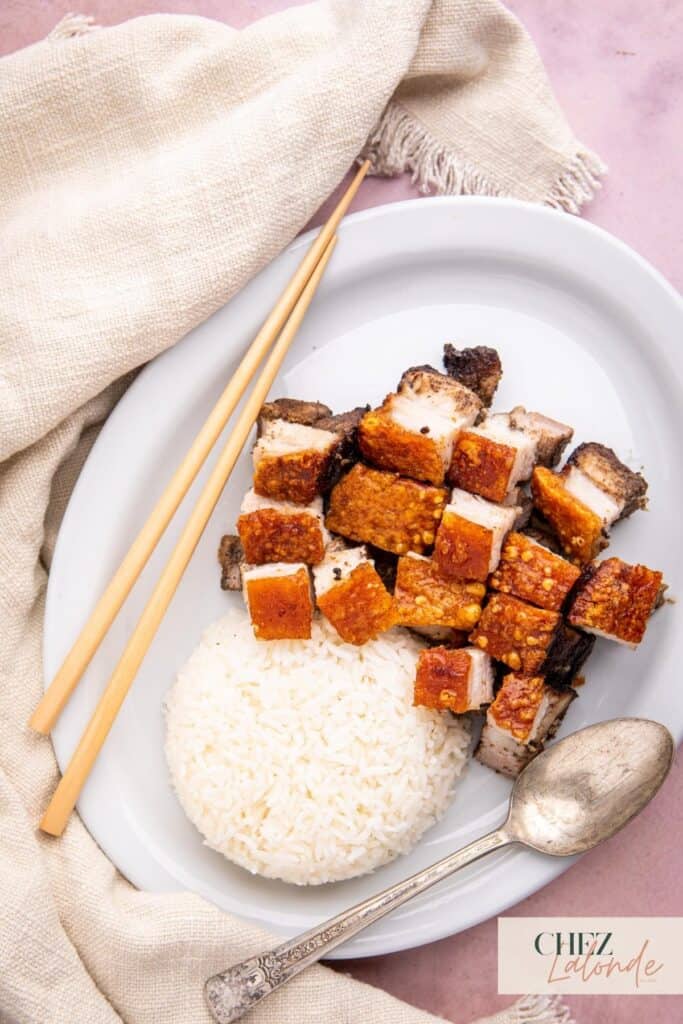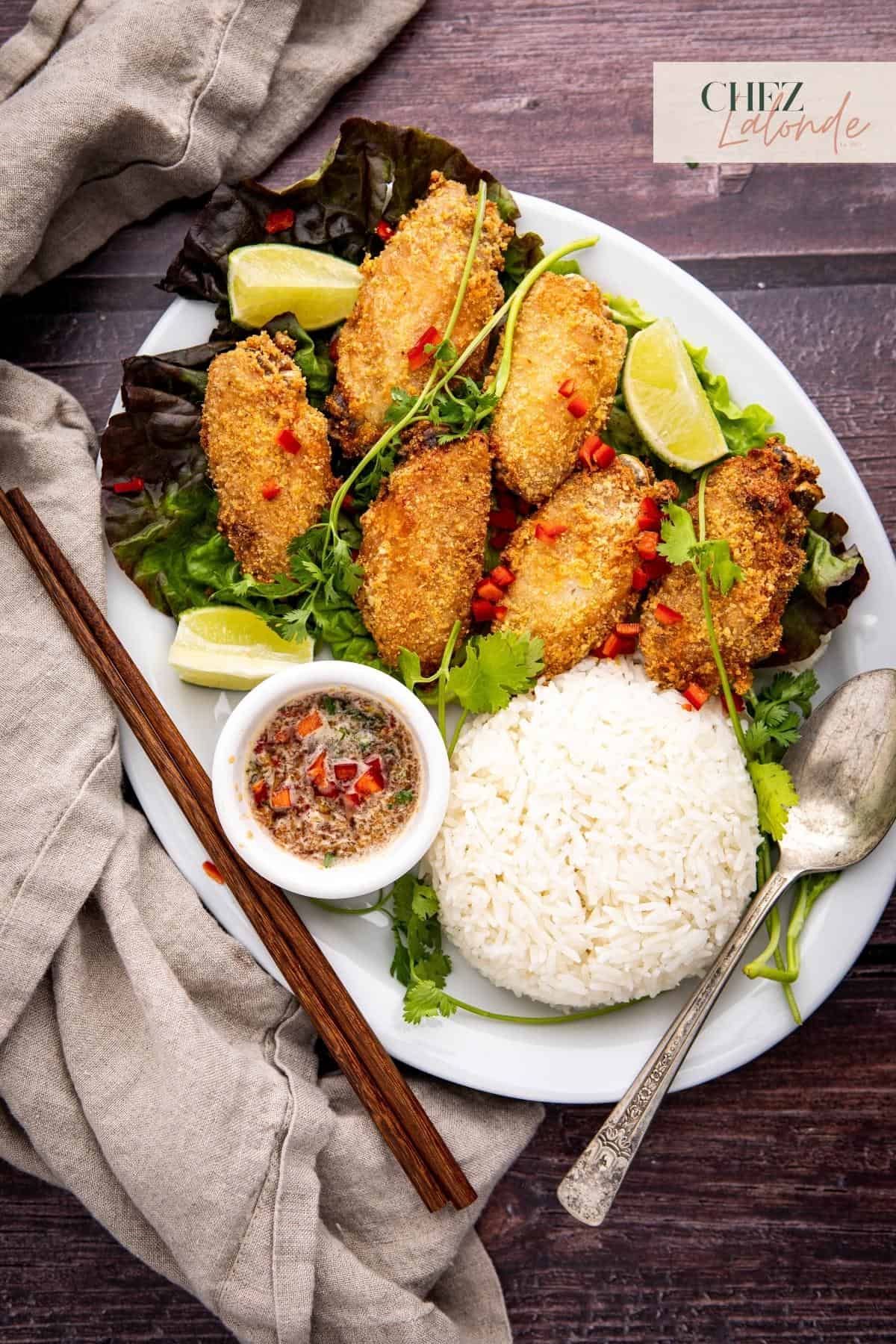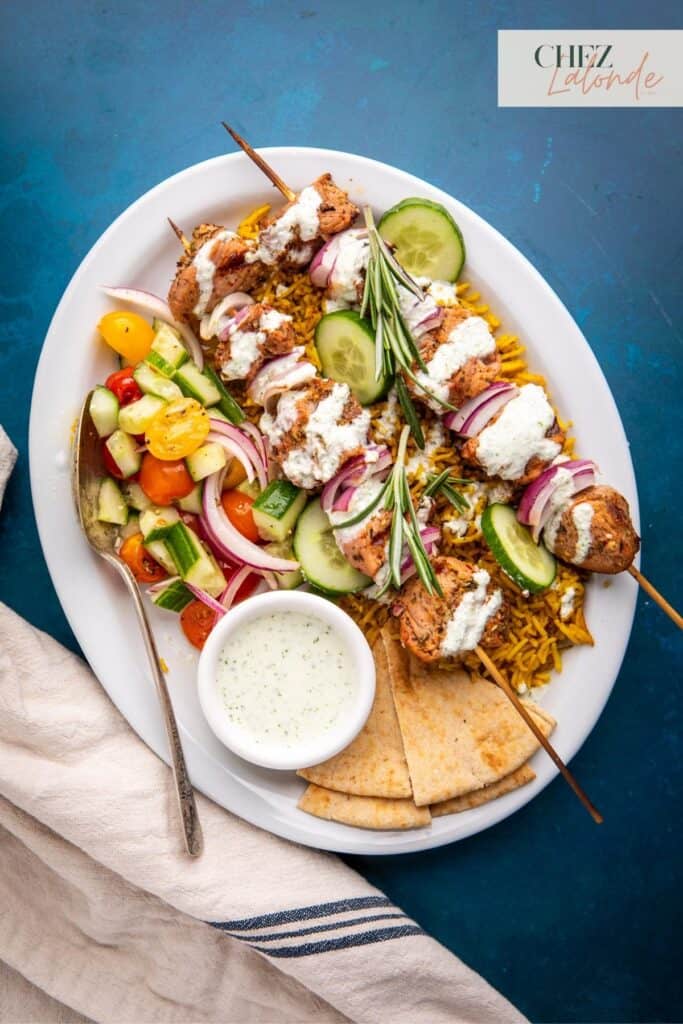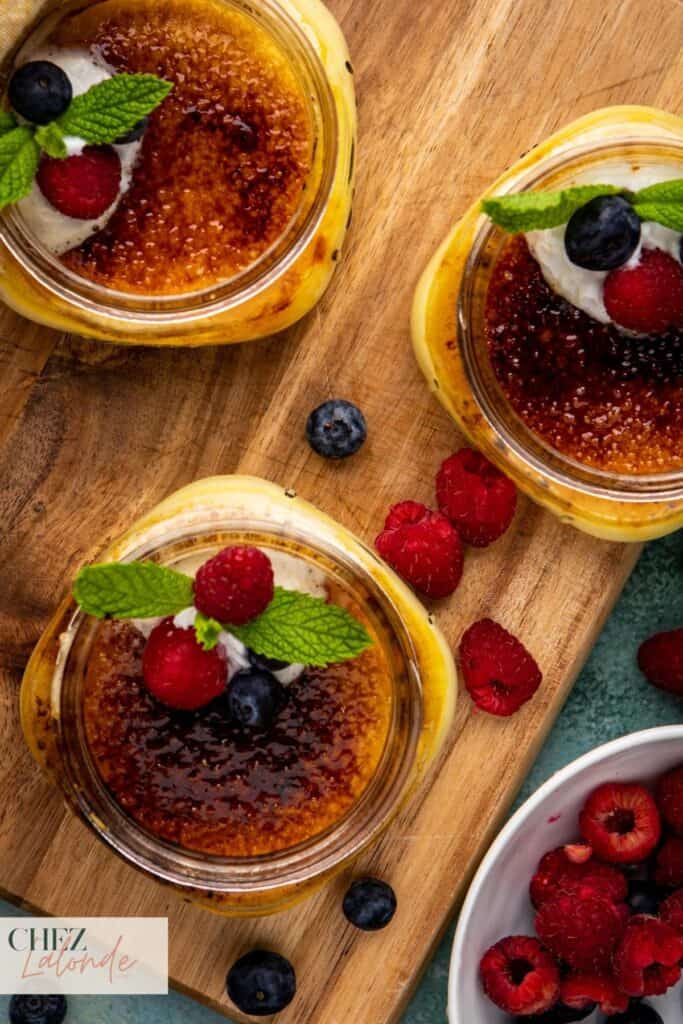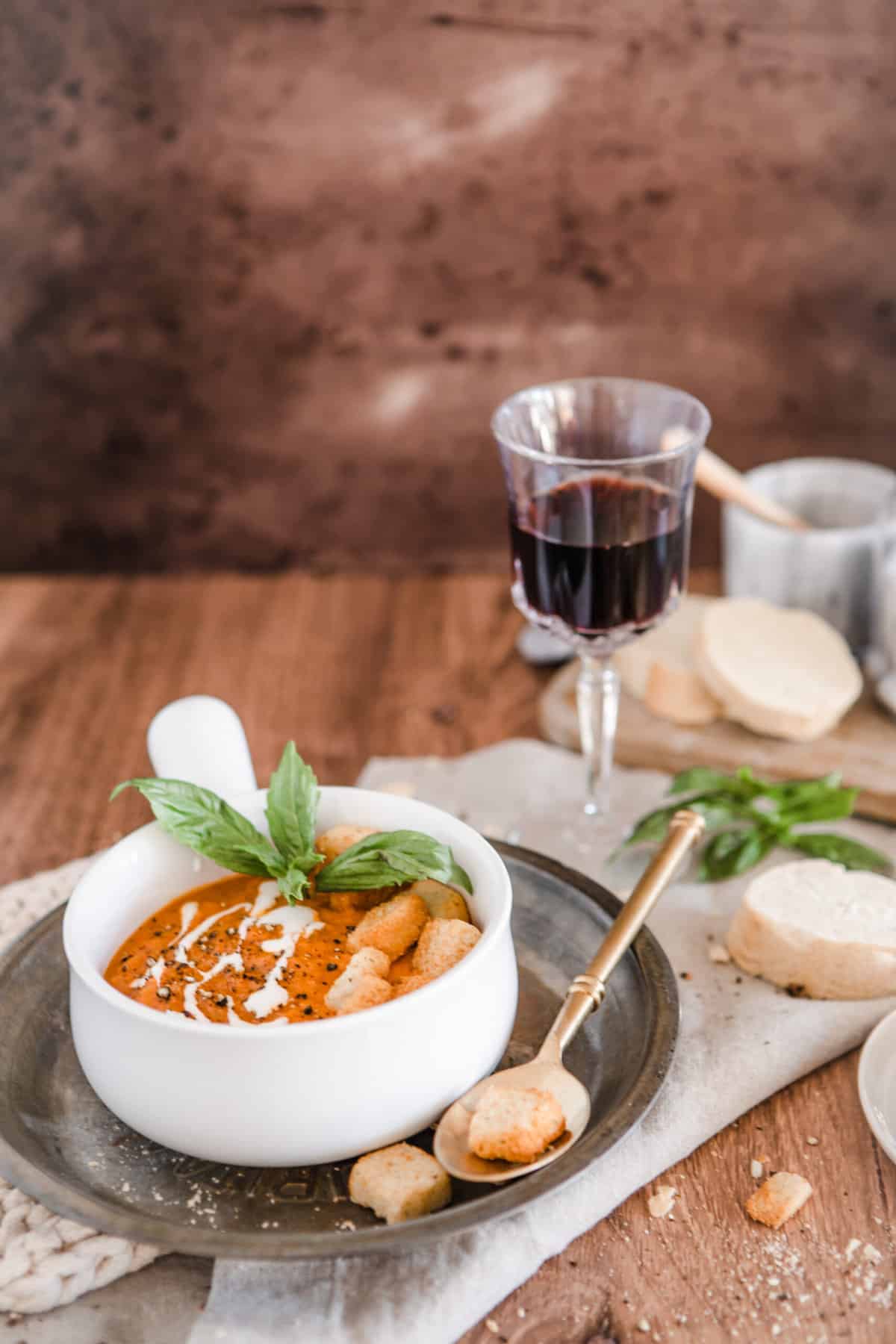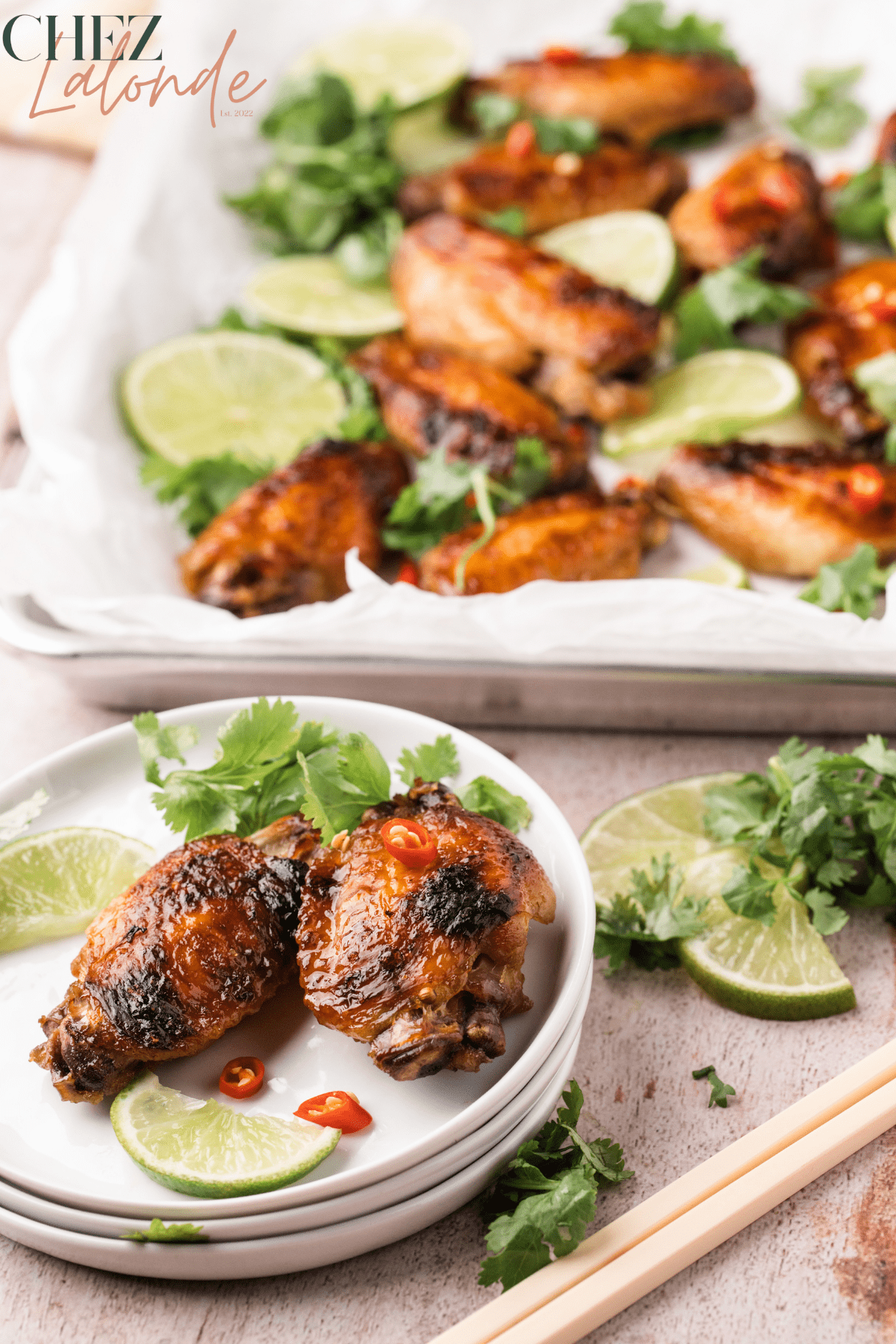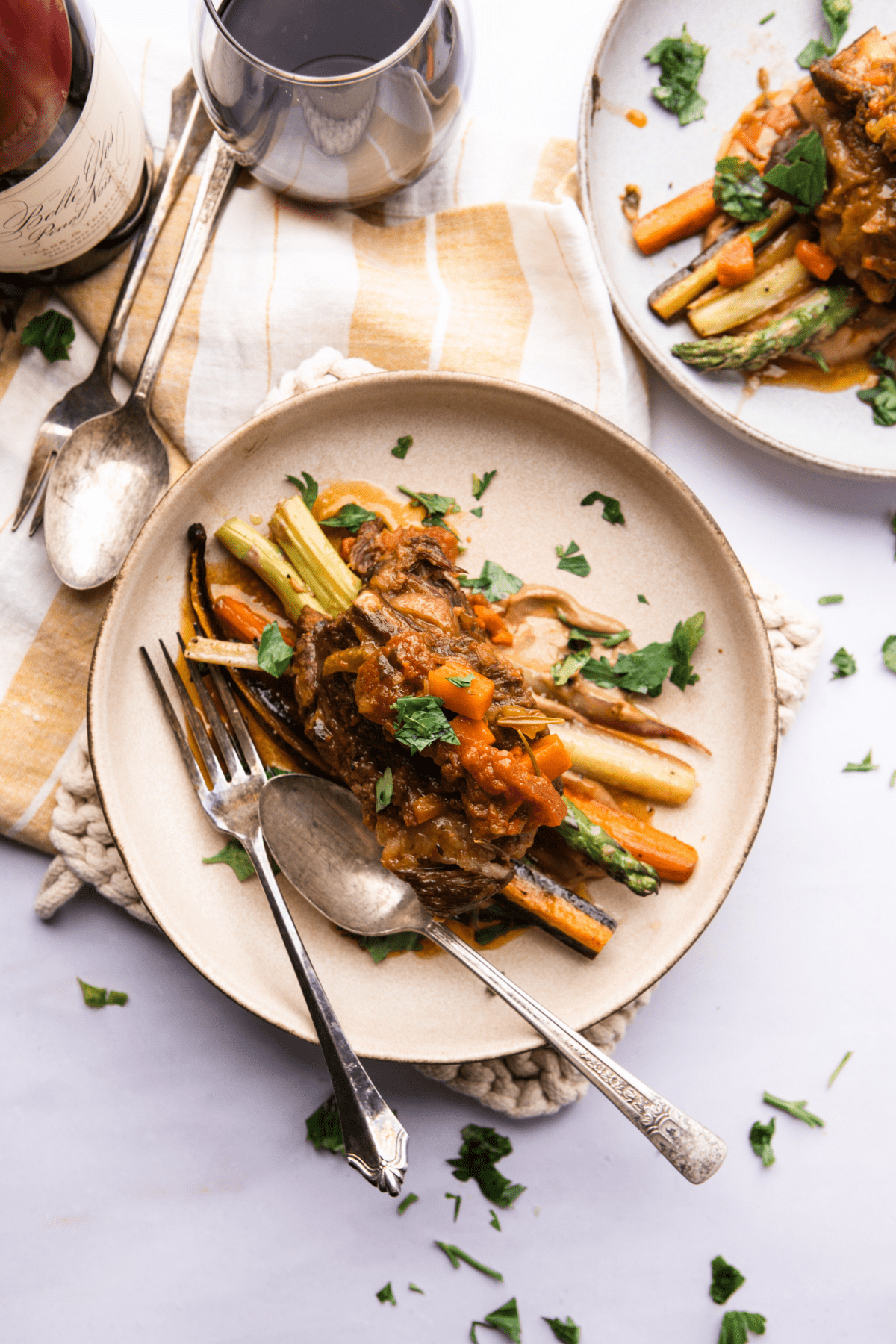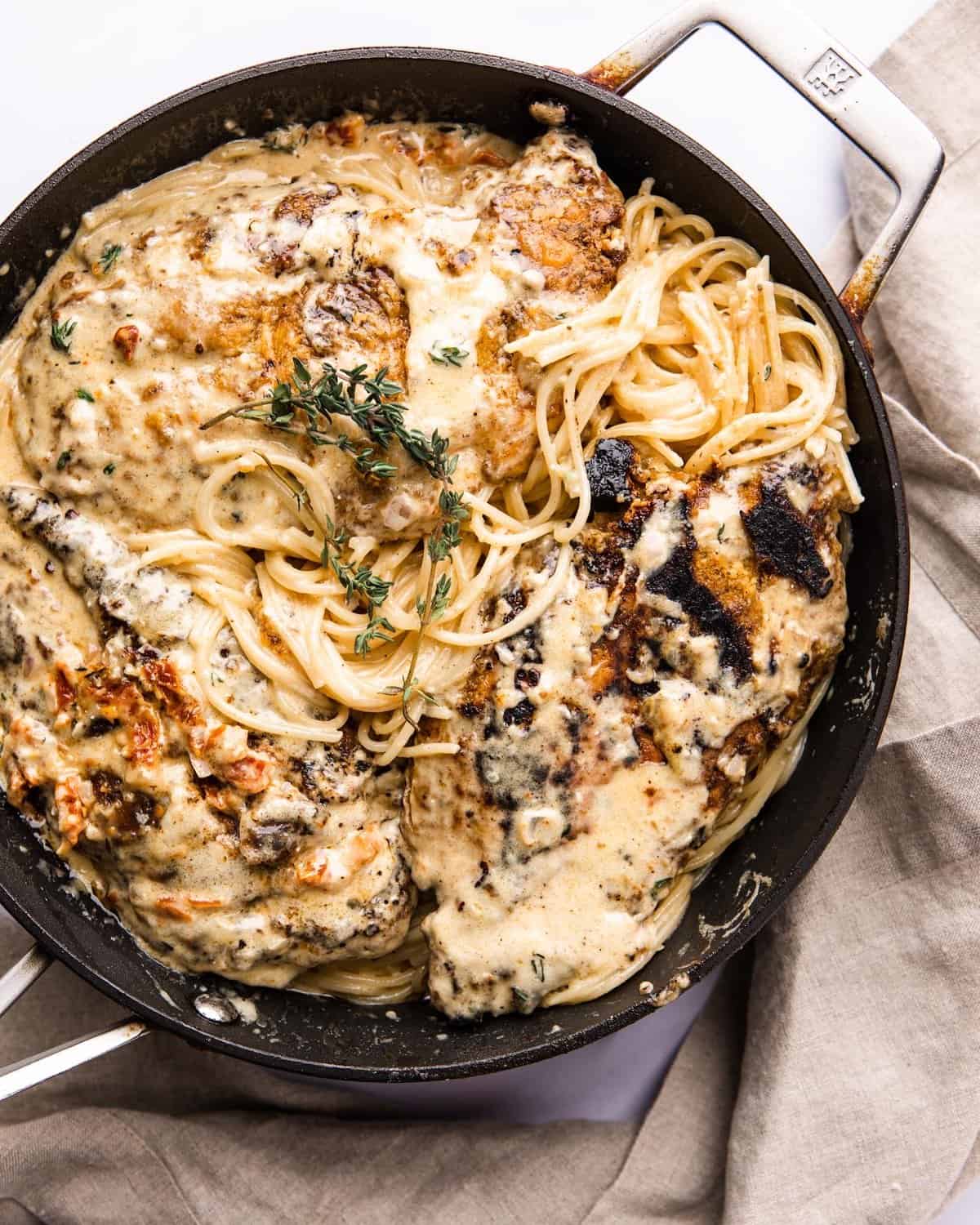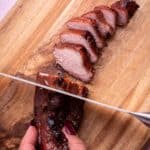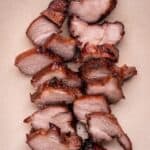Sous Vide Char Siu 叉燒 (Chinese-Style BBQ Pork)
Have you ever indulged in Chinese BBQ pork at your local joint? Char Siu (叉燒) is an iconic Cantonese dish sweeping the food scene globally. Once, this delectable dish was an exclusive restaurant treat because it takes a professionally trained chef to make. But guess what? Thanks to today’s advanced cooking technologies, you’re just steps away from restaurant-level perfection at home.
This post reveals my secret method of transforming tough pork cuts into succulent gourmet marvels. Prepare to turn ordinary tough-cut pork into a succulent masterpiece using a traditional Cantonese-style marinade with a modern twist – the Sous Vide cooking method.
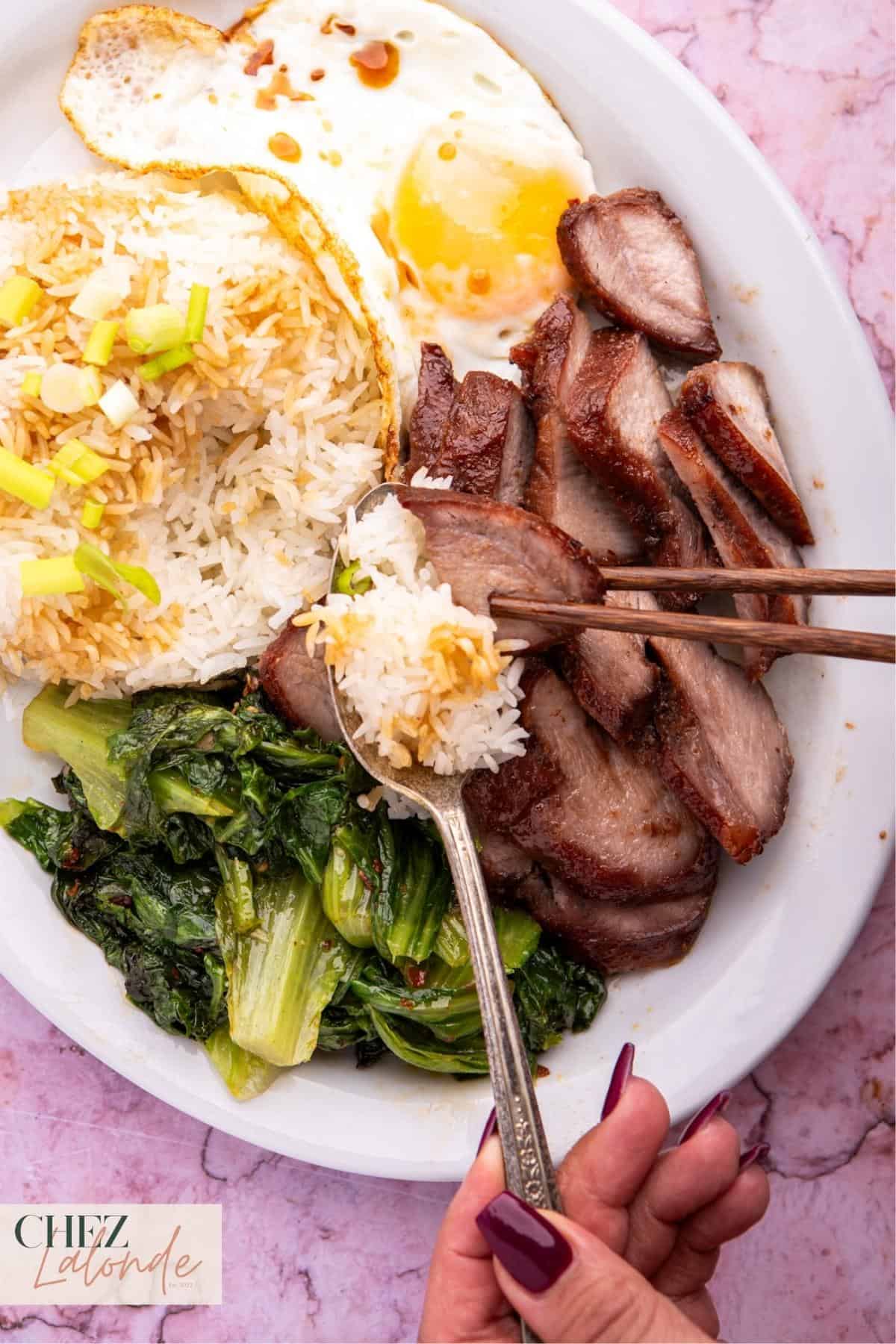
Disclaimer Notice: This website contains affiliate links. If you make a purchase through these links, I may earn a commission at no extra cost to you. I only endorse products or services I believe will be valuable to my readers. I appreciate your support.
Growing up in Hong Kong, enjoying Cantonese-style BBQ was a norm. From Char Siu (Chinese BBQ pork) to Siu Yuk (Chinese roasted pork belly), these delights graced our table on a weekly basis. Back then, making this BBQ pork at home was rare due to the need for specialized skills and equipment (I mean, come on, who has an open flame oven inside a 500 sqft flat?) We often turned to nearby Chinese restaurants for a quick fix.
However, thanks to today’s innovative technology, we can recreate these classics at home using tools like the Air Fryer, oven, or Sous Vide.
Now, why Sous Vide, you ask? I’m about to spill the beans and unveil my trusted technique for crafting succulent Chinese BBQ Pork using the innovative Sous Vide method.
Ready to dive in? Let’s get started!
Recipe Snapshot
EASE: Designed for all skill levels, this recipe brings simplicity to your kitchen.
PROS: The Sous Vide method delivers restaurant-quality Chinese BBQ Pork.
CONS: Be prepared for longer cooking times, a minor trade-off for the exquisite result.
WOULD I MAKE THIS AGAIN? Absolutely. This is our go-to weeknight meal.
What is a Char Siu 叉燒?
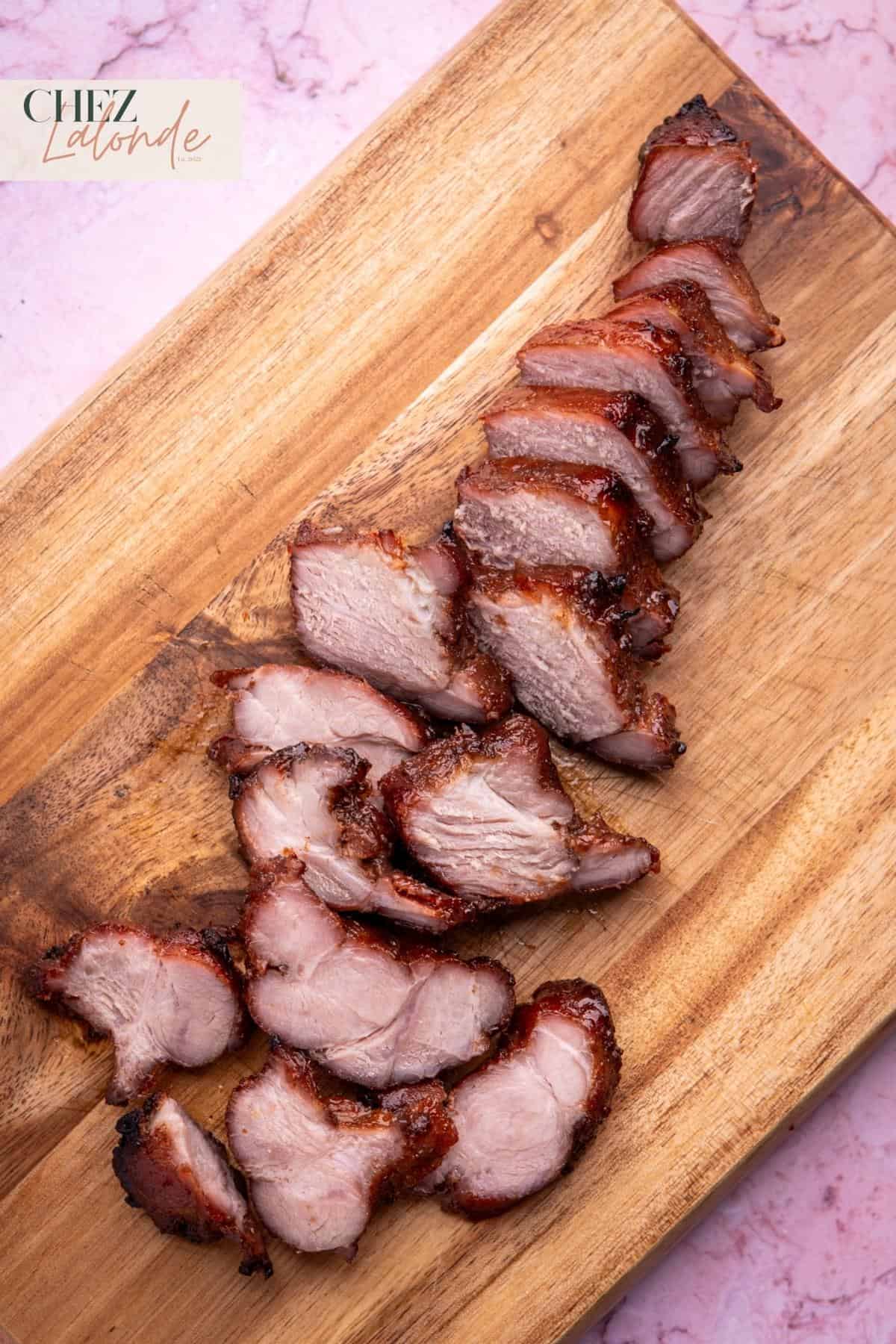
- Char Siu (叉燒), also known as Chinese Barbecue Pork, is a delectable dish featuring tender and juicy cuts of pork, often derived from Pork Butt, Shoulders, or even Pork Tenderloin.
- This culinary masterpiece boasts a delightful balance of sweet and savory flavors, making it a cherished entrée in Chinese cuisine.
- Char Siu’s versatility shines as it effortlessly complements an array of dishes, from Lo Mein noodles and fried rice to savory pastries like Char Siu Bao (Steamed BBQ pork bun). This renowned recipe has resulted in diverse adaptations tailored to local tastes and traditions in various Asian countries.
Where did Char Siu originate?
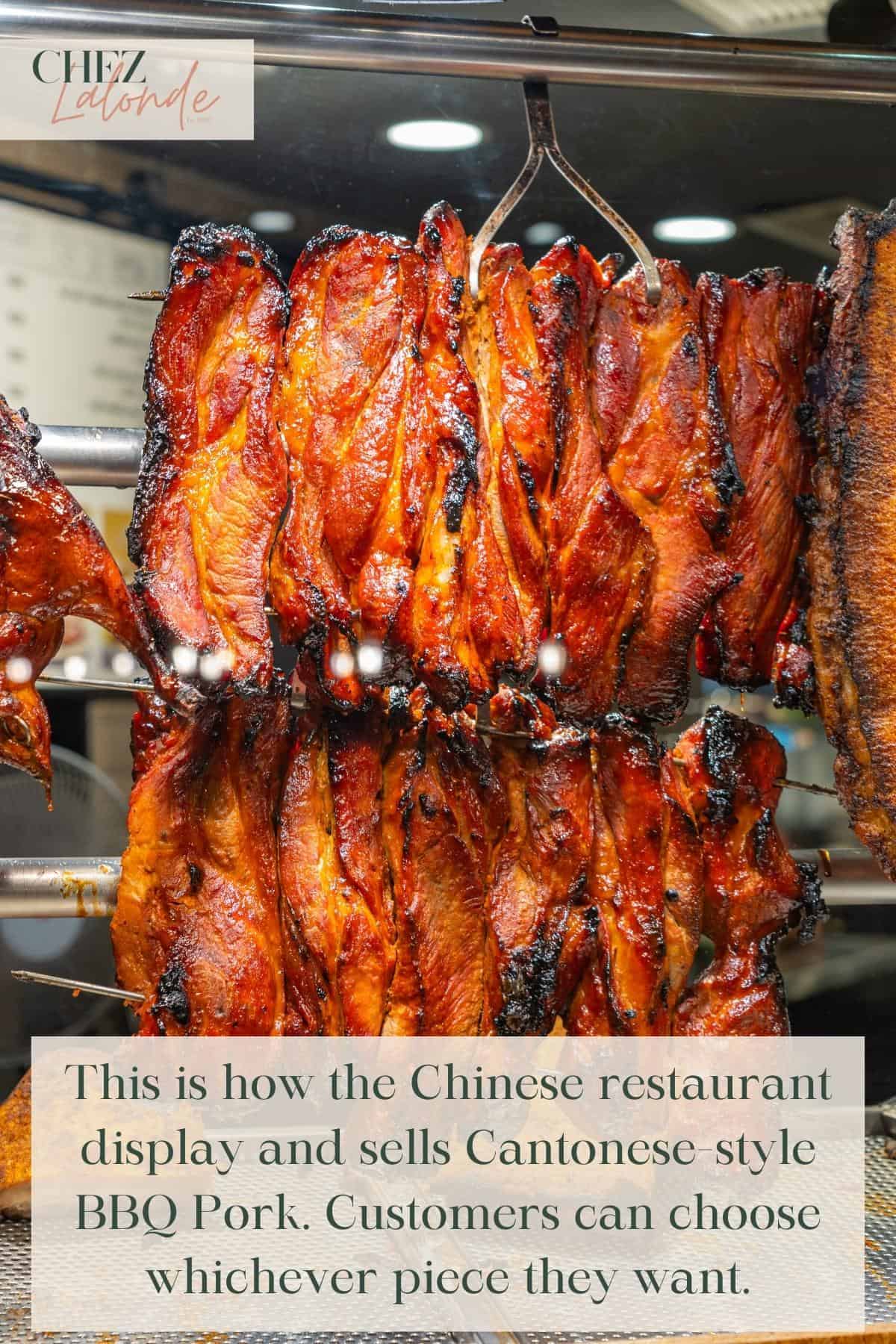
- Char Siu, often known as Chinese BBQ pork, traces its roots back to ancient China. It became a beloved dish across various regions of China, particularly in Southern Cantonese cuisine.
- The term “Char Siu” literally translates to “fork roasted,” referencing the traditional method of cooking the meat on long forks or skewers over an open flame. The meat, skewered on long forks, would hang over glowing embers, releasing an irresistible aroma and forming a deliciously charred outer layer.
- While the original Char Siu was often made using boar meat, modern versions typically feature pork cuts such as Pork Butt or Pork Shoulders, chosen for their succulent and flavorful qualities.
Why you’ll love to make this recipe with Sous Vide?

Gourmet-level tenderization and flavors:
The Sous Vide cooking method is the best way to guarantee that your pork results in a tender and juicy texture. The prolonged cooking allows the marinade to seep into every pork fiber.
A Foolproof cooking method:
No more meal mishaps of overcooked or undercooked disasters. Say goodbye to guesswork, as precise temperature control guarantees flawless, consistent results every time you make this dish.
Time-Tested Tradition with a Modern Twist:
It’s like an old family recipe with a modern makeover. You get to honor the time-tested tradition of Char Siu while embracing the innovative Sous Vide technique, creating a classic and contemporary dish.
What is Sous Vide?
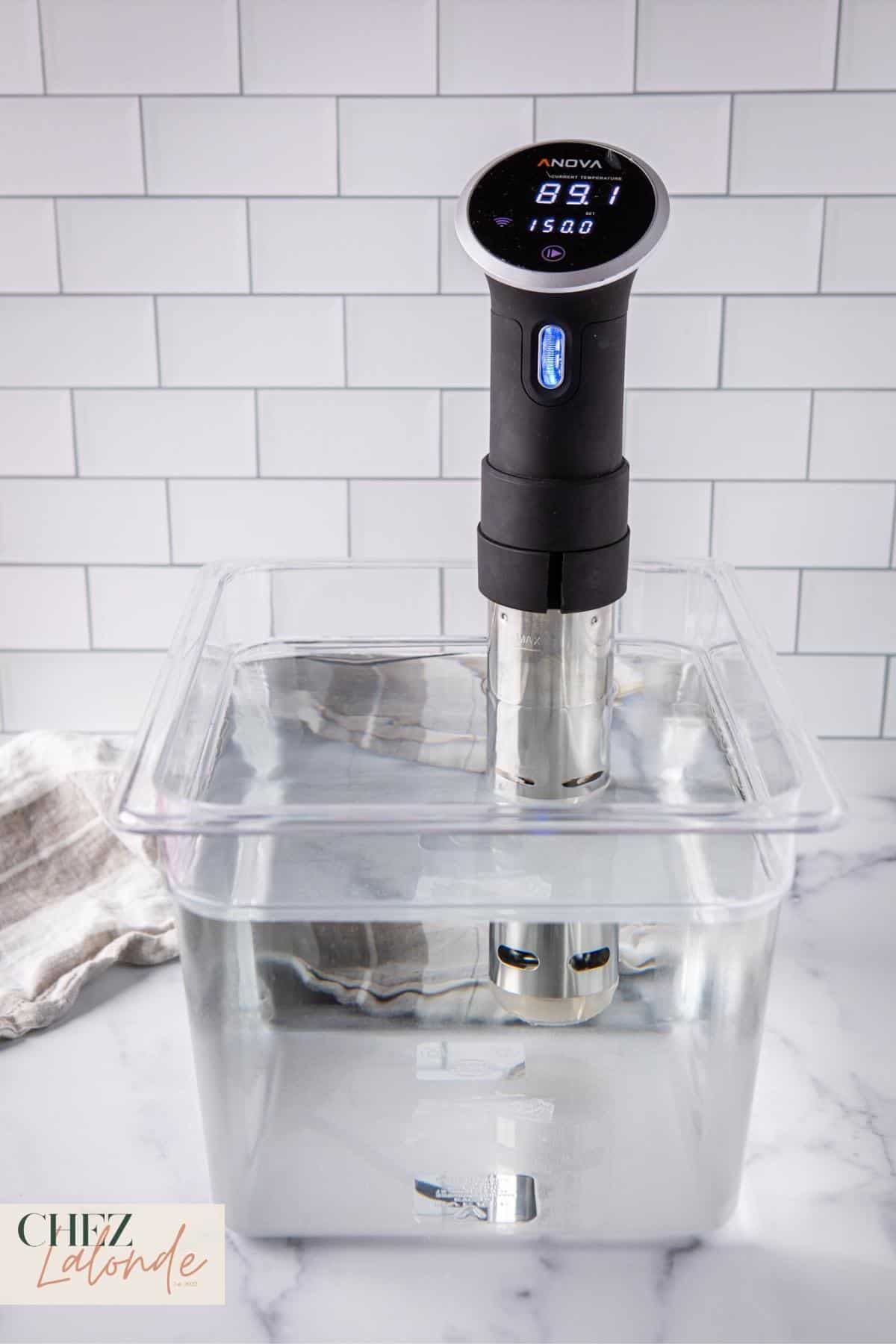
Sous Vide is a French cooking technique that involves vacuum-sealing (Placing your pork in a Ziploc bag or a vacuum-sealed bag) in the rich marinade and cooking slowly in a precisely temperature-controlled water bath for an extended time. This method ensures that every fiber of the pork absorbs a harmonious blend of flavors, resulting in a tender and juicy outcome.
Can’t I roast the Char Siu in an oven?

Of course, you can roast the pork in an oven to save time and skip the Sous Vide process. But here’s the deal: Sous Vide ensures even cooking.
Why? Well, ovens can sometimes be finicky with their temperatures. Mess it up, and you’re stuck with either dry, overcooked Char Siu or the disappointment of undercooked bites. Sous Vide guarantees an even cook from edge to edge.
And guess what? A quick finish in an air fryer or under the broiler to achieve that mouthwatering, restaurant-style BBQ look you’re craving.
What is the difference between Chinese-style and Japanese-style Char Siu?

Chinese-style Char Siu:
- Flavor Palette: Balanced sweet, and savory, often featuring hoisin sauce and soy sauce.
- Marinade: Soy-based with hints of hoisin, honey, and five-spice powder.
- Texture: Tender, juicy, and slightly caramelized.
- Cooking Method: Traditionally fork-roasted or oven-baked, occasionally sous vide.
- Presentation: Glossy reddish-brown glaze.
- Usage: Key dish ingredients include noodle bowls, rice plates, and Char Siu Bao.

Japanese-style Char Siu:
- Flavor Palette: Umami-forward, often influenced by Japanese seasonings.
- Marinade: Mirin, sake, soy sauce, and possibly miso or ginger.
- Texture: Tender, with a balanced sweetness and savory depth.
- Cooking Method: Grilled or roasted, sometimes with a smoky touch.
- Presentation: Less glossy, more emphasis on smoky char.
- Usage: Found in ramen bowls, rice dishes, and fusion creations.
What are the best cuts of pork to use for this recipe?
When aiming for that authentic Chinese restaurant-style Char Siu experience, stick to the classic cuts – Pork butt or shoulder. They have a perfect balance of fat-meat ratio that turns each bite into a savory succulent masterpiece.
But you might have seen other recipe calls for Pork Tenderloin. While if you dislike fatty pork, pork tenderloin can be your alternative. However, know that it is a lean cut, and the texture is more dry and will not have that succulent outcome.
But when it comes to it, you can decide which cut you would like. I will always vote for the Pork Butt or shoulder cuts for a more authentic taste.
What is the difference between Pork butt VS. Pork shoulder?
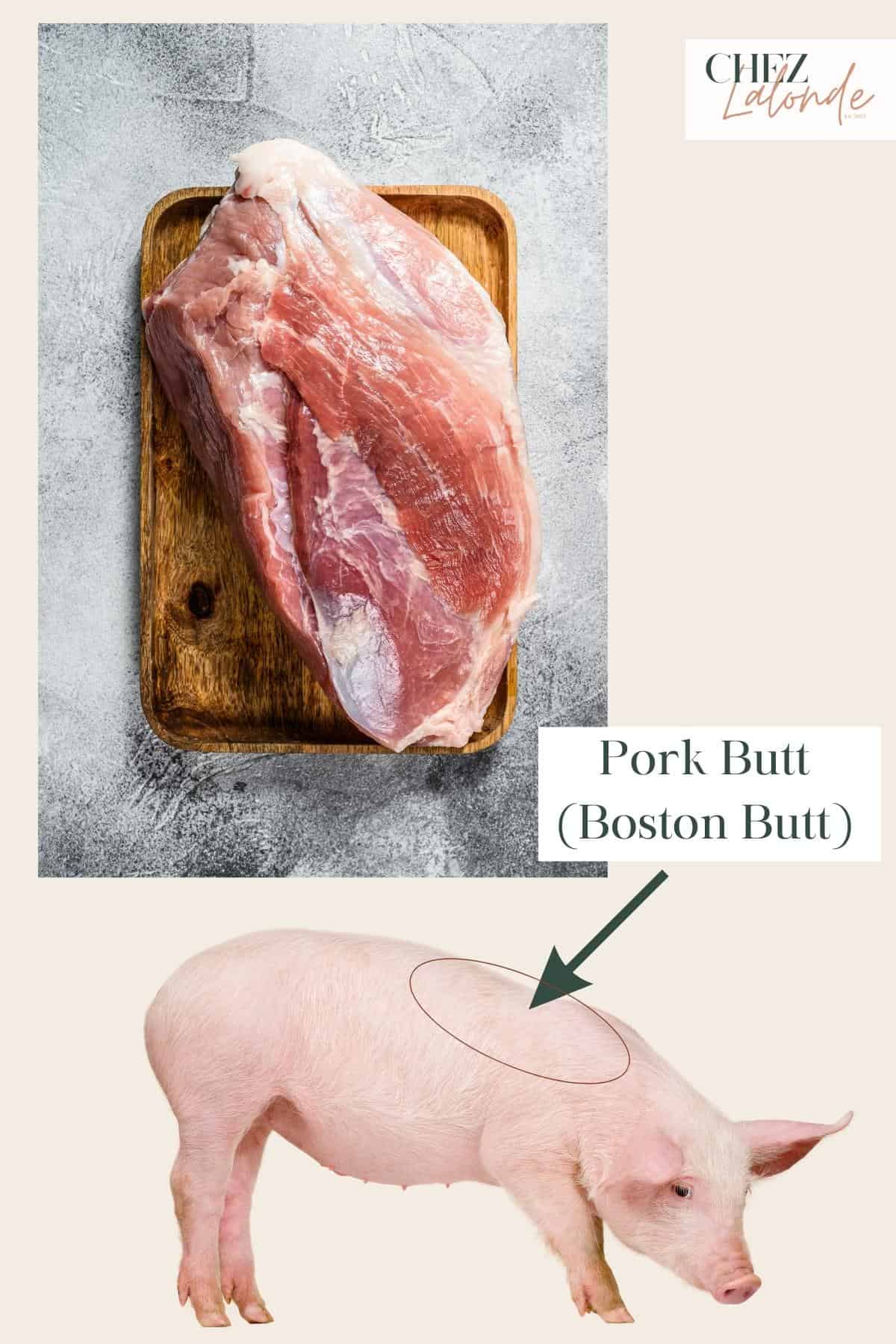
Pork Butt:
- Cut Location: The pork butt is actually cut from the upper part of the shoulder, closer to the back of the pig.
- Marbling: It tends to have more marbling, contributing to its rich flavor and juiciness.
- Texture: The meat of pork butt can be slightly denser and meatier than pork shoulder.
- Cooking Techniques: Pork butt is often used for slow cooking methods like roasting, smoking, and braising due to its higher fat content.
- Uses: It’s a popular choice for pulled pork dishes and barbecue due to its tender, succulent meat.
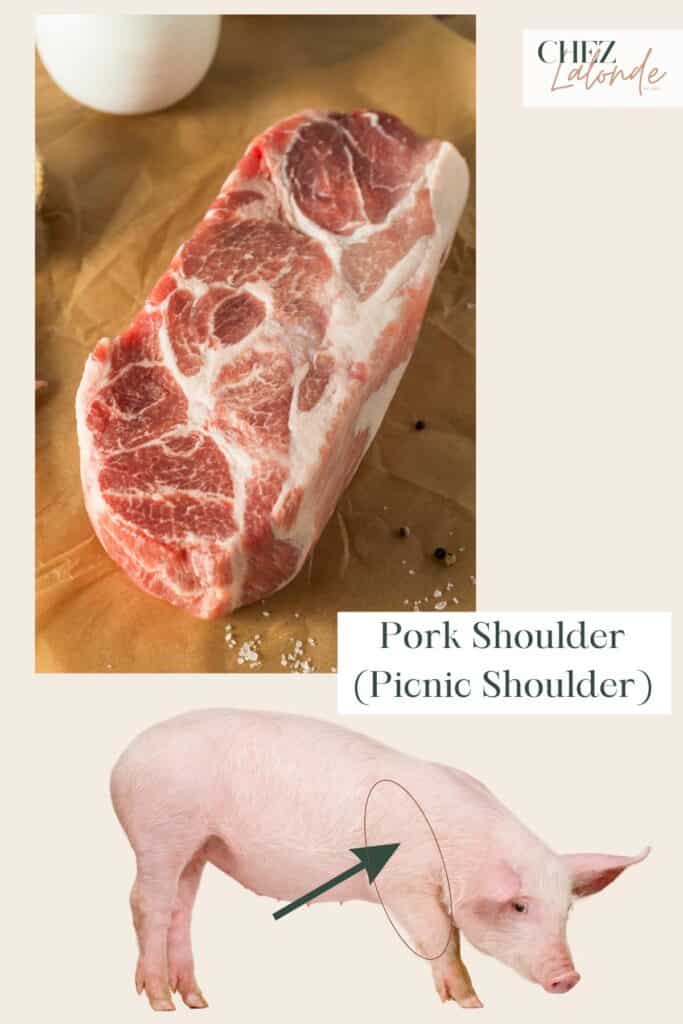
Pork Shoulder:
- Cut Location: The pork shoulder includes the upper part (pork butt) and the shoulder’s lower part (picnic shoulder).
- Leaner: The lower part of the shoulder, known as the picnic shoulder, is typically leaner with less marbling.
- Versatility: Pork shoulder is versatile and can be used in various cooking methods, from slow roasting to braising and grinding for sausages.
- Texture: The meat from the picnic shoulder can be slightly tougher compared to pork butt, but it can still become tender and flavorful when cooked low and slow.
- Uses: It’s commonly used for making stews, casseroles, and Cuban-style roast pork.
Ingredients that you’ll need to make this recipe:

Chinese condiments and sauces that I used in this recipe
By displaying the products below, I hope you’ll be able to find them effortlessly online or at your nearby Asian supermarket.

Chinese Rose Wine
Regular Soy Sauce
Fermented red bean curd
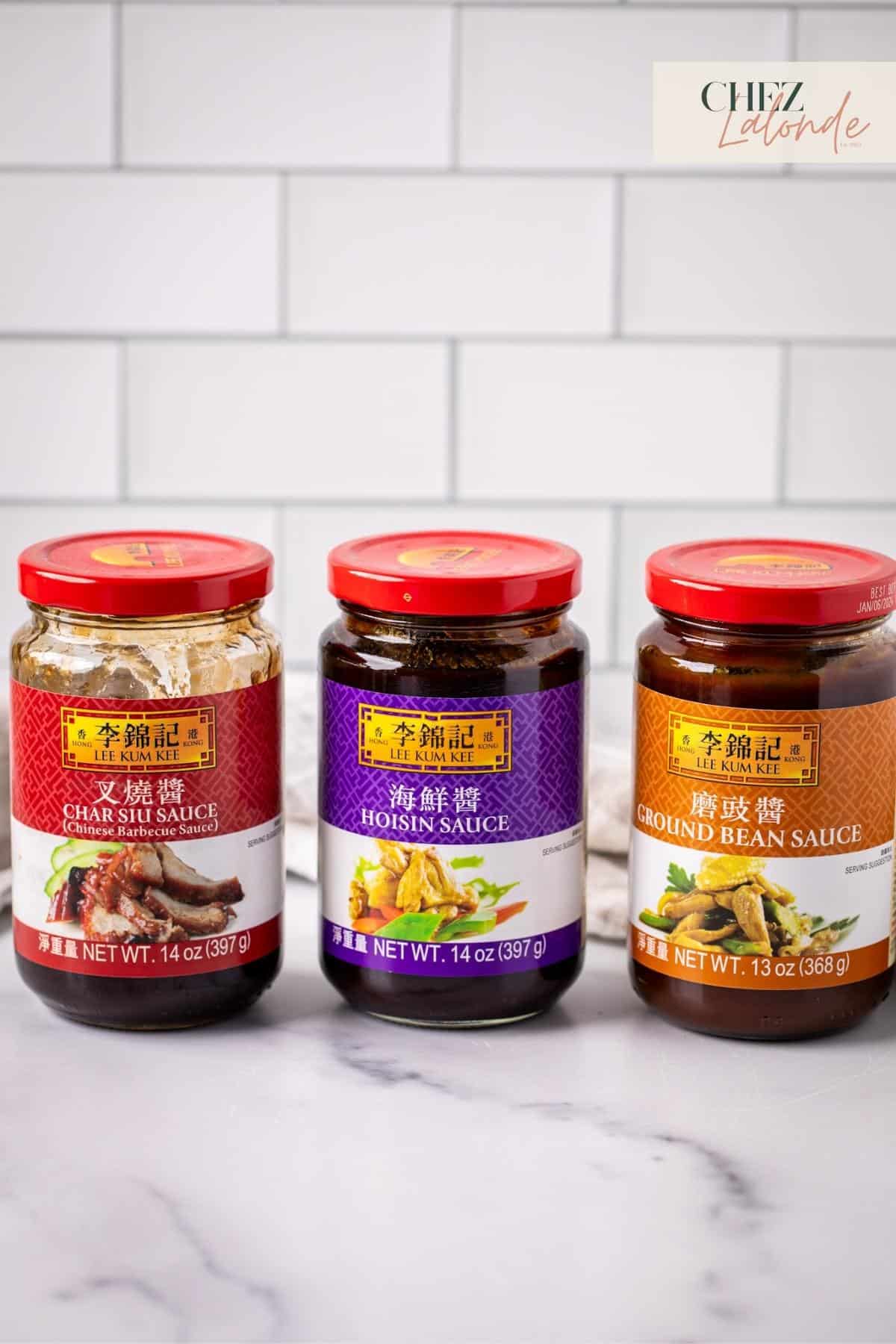
Char Siu Sauce
Hoisin Sauce
Ground Bean Sauce
(All from my favorite brand Lee Kum Kee)
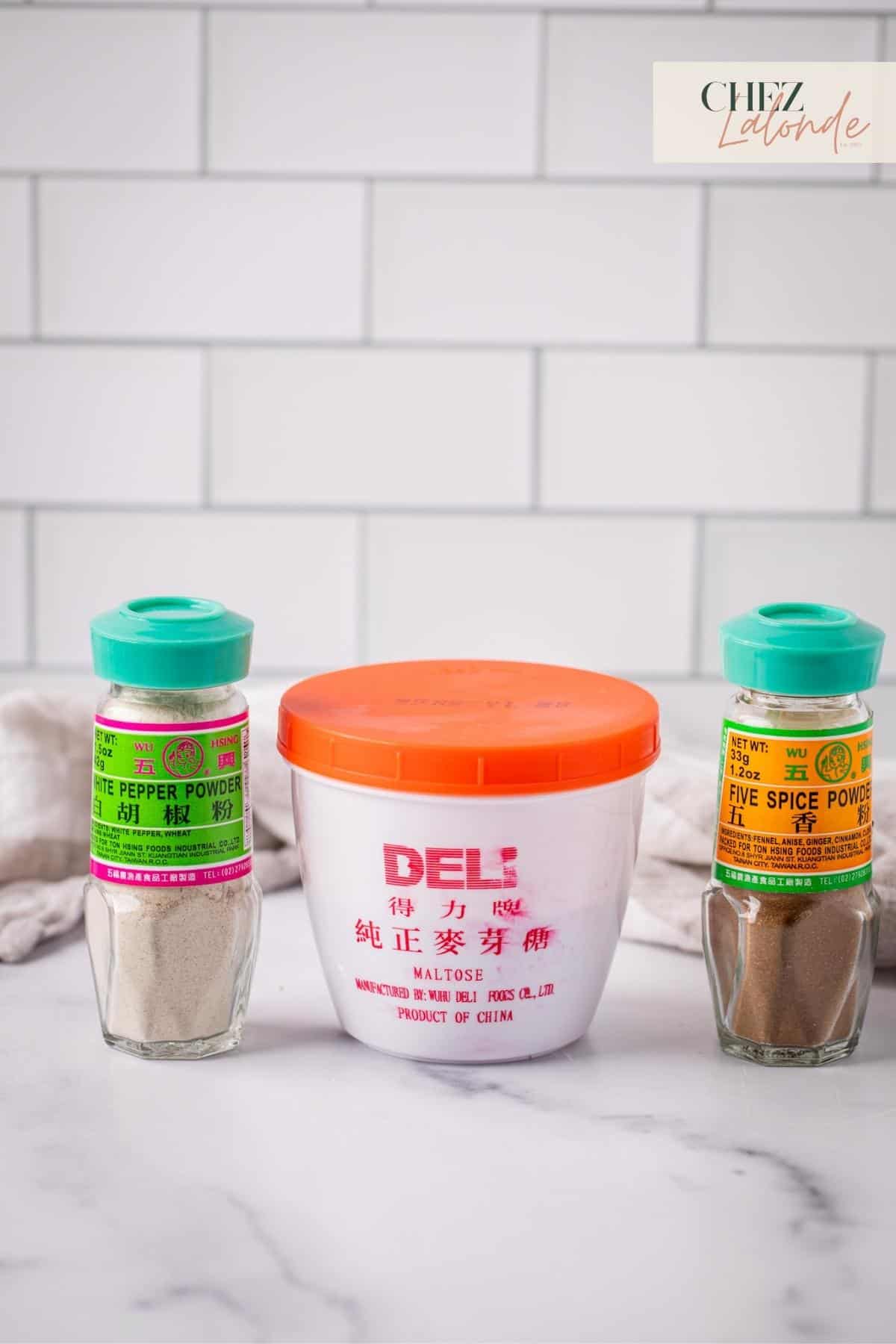
White pepper
Maltose syrup
Five spice powder

Don’t know how to use these Asian sauces & condiments?
Check Out My Chinese Pantry Essential Guide To Learn More
Pork Butt or Shoulder: The star of the show, it is the meat base for a succulent and flavorful Char Siu.
Char Siu Marinade:
- Egg: Adds richness and helps bind marinade ingredients.
- Fermented red bean curd and juice- It helps boost the color of the meat, and it has a unique fragrance to enhance the taste.
- Chinese Rose Wine: Imparts aromatic depth and enhances the overall marinade.
- Soy sauce: Infuses rich umami depth into the pork, enhancing its savory profile.
- Ground bean sauce: Adds a unique, earthy flavor and smooth texture to the marinade.
- Hoisin sauce: Balances the sweetness with a hint of tanginess, creating a well-rounded taste.
- Char Siu sauce: it brings authenticity and signature flavor to the dish.
- Red food coloring: Optional for achieving that vibrant, appetizing appearance.
- Maltose Syrup: This creates a glossy, attractive finish and adds a touch of sweetness.
- Hot Water: Help to melt the Maltose syrup.
Dry Rub Mixture:
White Pepper, Five spice powder, garlic powder, and sea salt
This mixture serves as a flavorful, aromatic coating for the pork. As the pork undergoes the Sous Vide cooking process, the dry rub melds with the meat, enhancing its taste and contributing to the overall richness of the dish.

Recipe Substitutions and Variations:
Natural color boost:
If you’re not a fan of food coloring, skip it! Instead, use a chunk of fermented red bean curd and a bit of its juice to enhance that appetizing hue.
Explore other protein options:
The marinade for Chinese BBQ pork works wonders on proteins like chicken thigh or breast. I stumbled upon the Char Siu Chicken recipe on The Woks of Life – definitely worth checking out and trying. While chicken shines, I’d suggest steering clear of beef, this marinade, as the flavors might not sync as seamlessly.
Swap maltose syrup with honey:
If Maltose syrup is scarce at your local store or online, don’t fret! Swap it out for honey. Like Maltose syrup, honey adds a glossy, succulent appearance, making your pork irresistibly juicy and inviting.
A lazy marinade alternative:
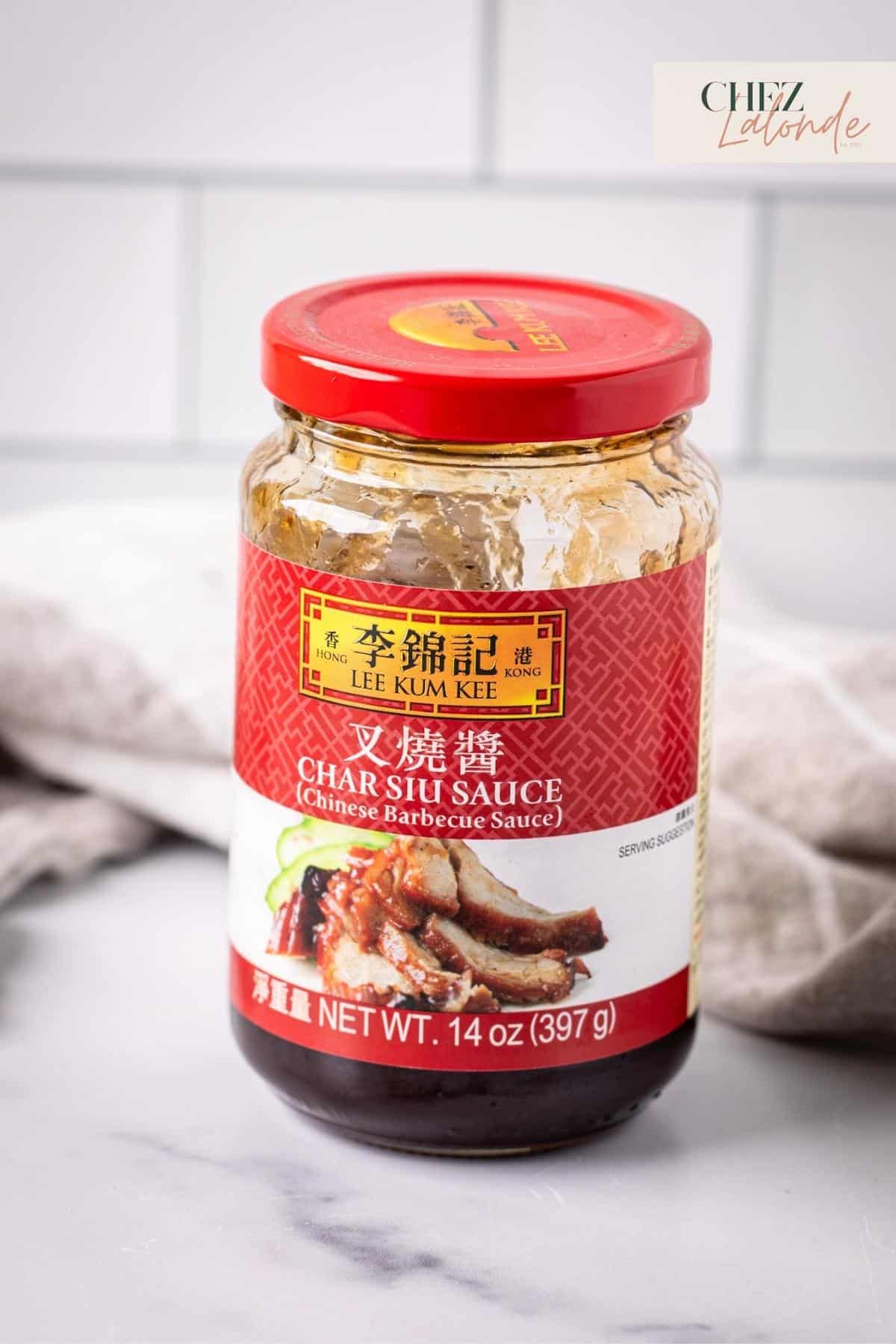
Are you feeling overwhelmed by the laundry list of Chinese sauces and spices? No worries! A straightforward route is to use the Lee Kum Kee Char Siu sauce. Before I came up with this recipe, I used to marinate 2 lbs of pork tenderloin with about half a jar of this Char Siu sauce on the left. It is perfect when time is tight or if an Asian supermarket isn’t around the corner. But if you’re aiming for the genuine taste of Chinese restaurant BBQ pork, I urge you to embrace the ingredient adventure. Once you get the hang of it, you’ll be whipping up this recipe countless times, ensuring no ingredient goes to waste!
Try another cooking method:
No Sous Vide precision cooker? No problemo! Here are some other ways to cook Char Siu:
Using an Oven:
Pop your marinated BBQ pork into the oven and roast it at 400F/200C for roughly 35 to 45 minutes, tweaking the time if your pork is a different size. Give it a quick check with a meat thermometer. It is ready to enjoy once the internal temperature reaches 145F/63C. Also, do not forget to baste BBQ marinate on the pork every 10 minutes to ensure the surface won’t dry out.
Using An Air fryer:
Grab your air fryer for that classic charred touch. Preheat it to 400F/200C for 5 minutes, toss in the marinated pork, and cook for 30 to 35 minutes. Remember to flip halfway for an even golden hue and baste BBQ marinade on the pork so it won’t dry out. And, of course, use the trusty internal meat thermometer to check the temperature to ensure it’s cooked just right.
How to make this recipe with Sous Vide?
Step 1: Clean and trim the pork
Begin by carefully removing any silver lining, impurities, or excess fat from the pork. Rinse it under running water thoroughly and gently pat it dry using fresh paper towels.
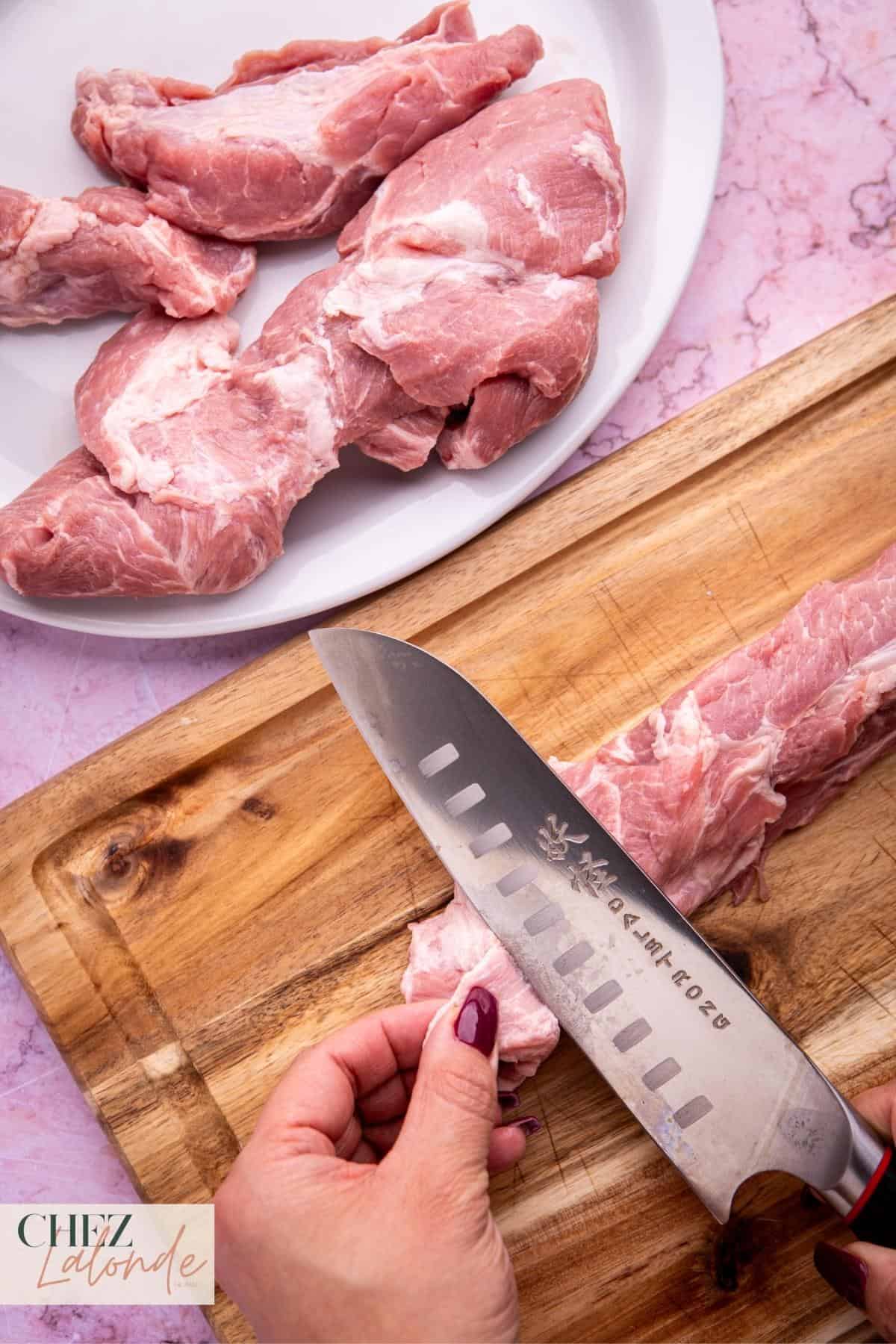

Step 2: Apply dry rub on the pork
In a small dish or bowl, combine ¼ teaspoon of white pepper and ½ teaspoon each of sea salt, five spice powder, and garlic powder. Sprinkle the dry rub mixture evenly over the pork and gently massage the flavors into the meat. Set aside and allow the seasoned pork to rest for 15 to 20 minutes, giving the flavors time to meld and enhance.
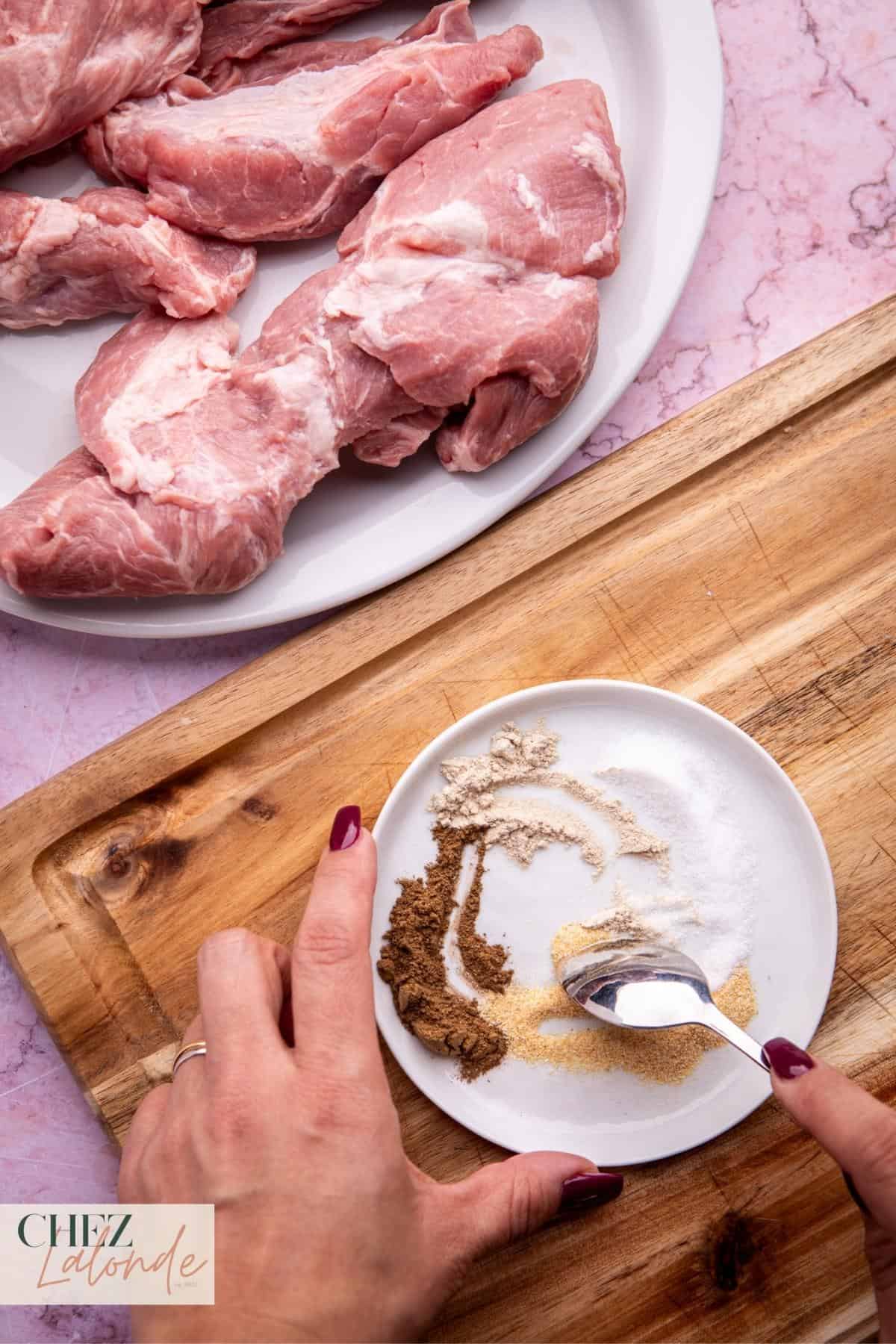
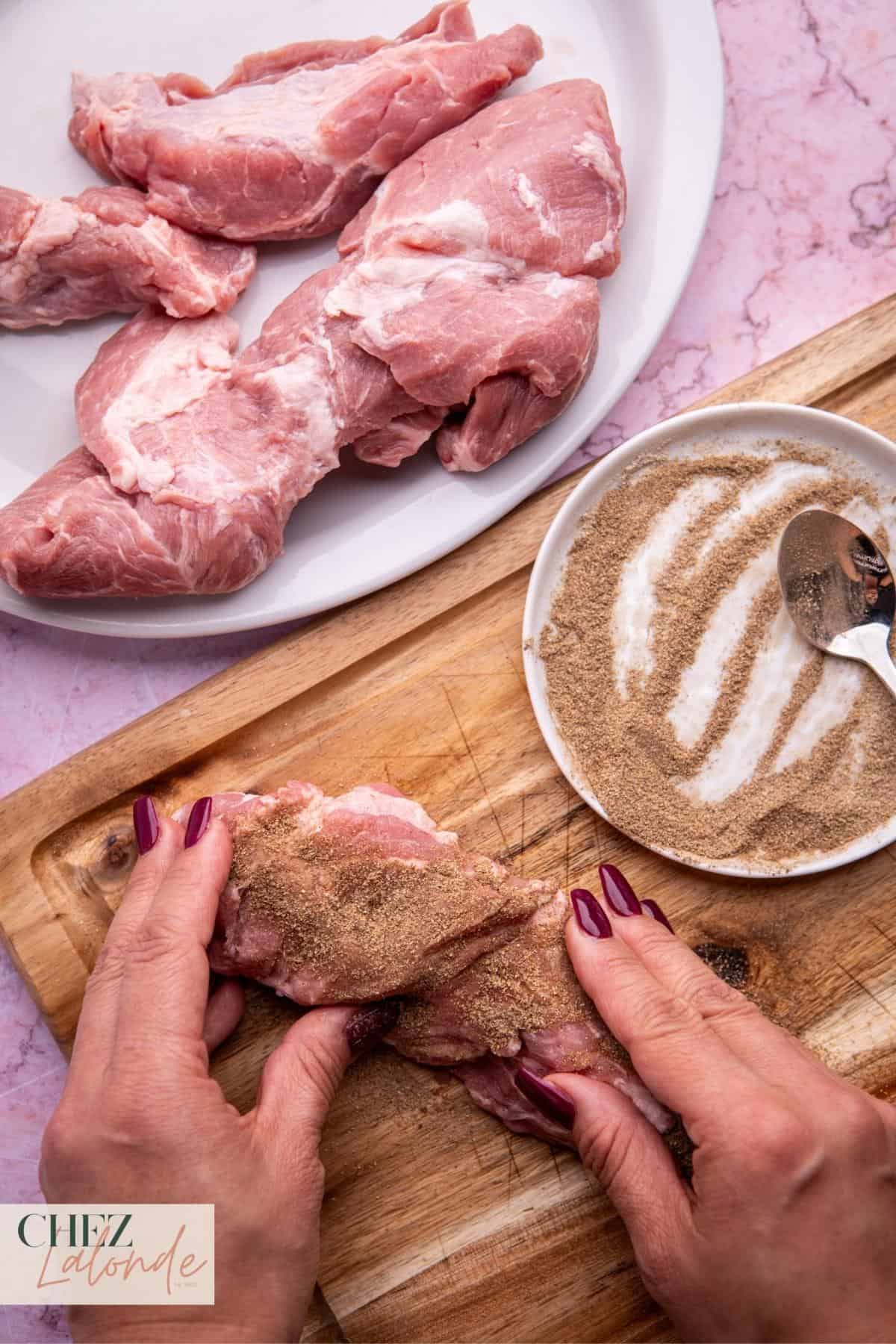

Step 3: Prepare Char Siu Marinade
While the pork is resting, start to prepare the Char Siu marinade. In a large bowl, whisk a large egg, combining it with a piece of fermented red bean curd and a tablespoon of red bean curd juice. Break down the bean curd into finer pieces using your whisk. Once integrated, add the remaining marinade ingredients, including soy sauce, Chinese rose wine, sugar, salt, ground bean sauce, Hoisin sauce, and Char Siu sauce. Whisk and make sure all are well combined.
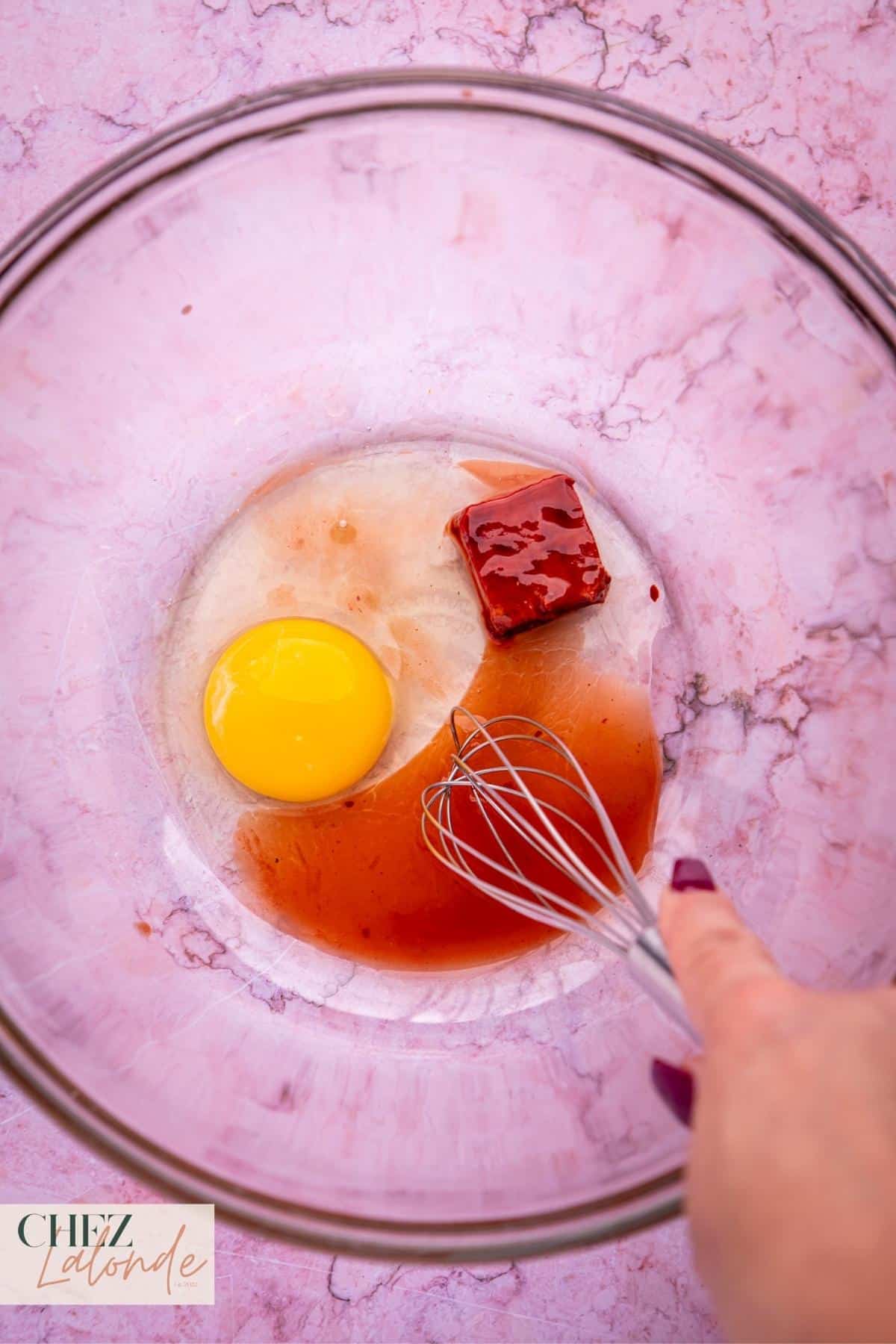
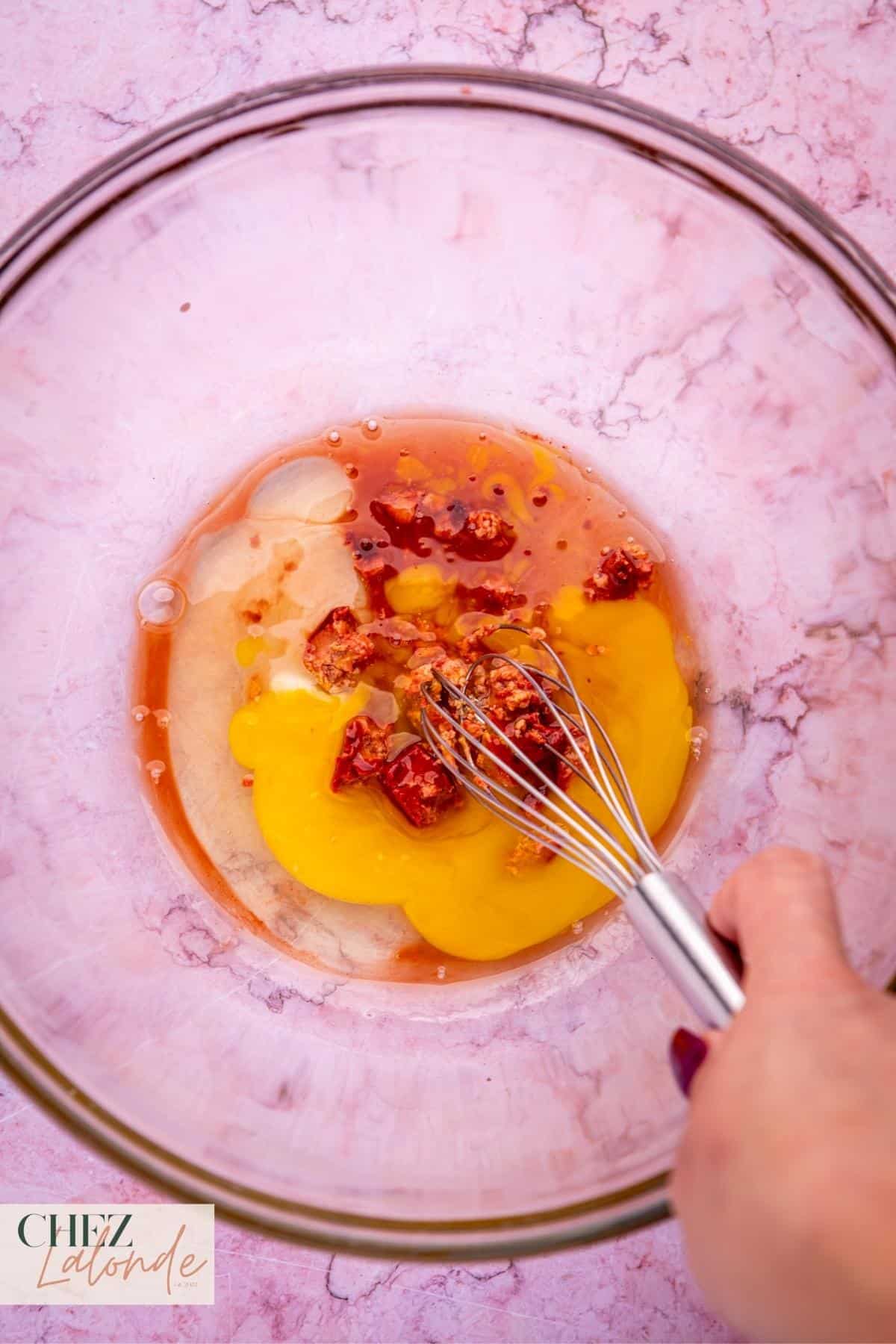
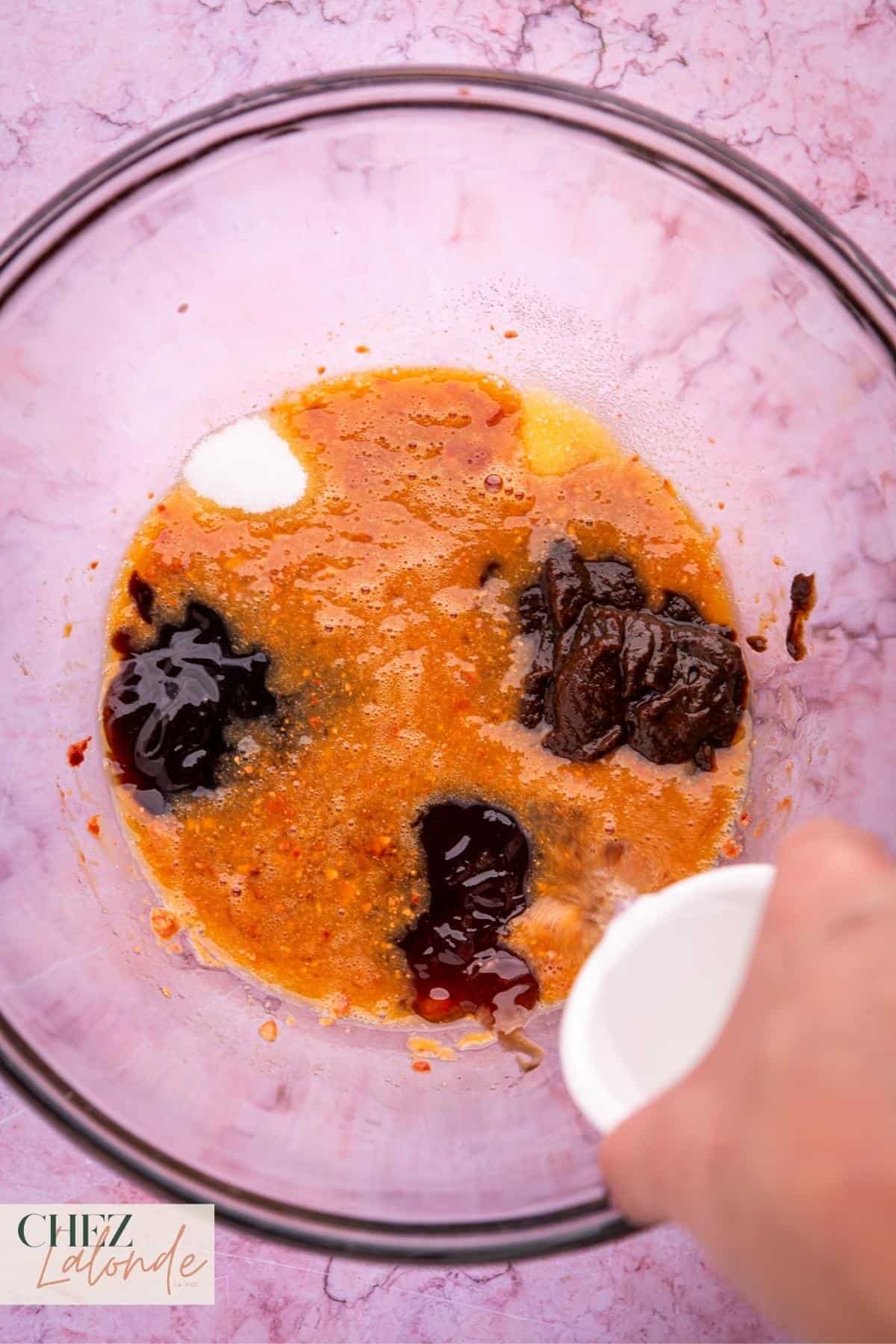
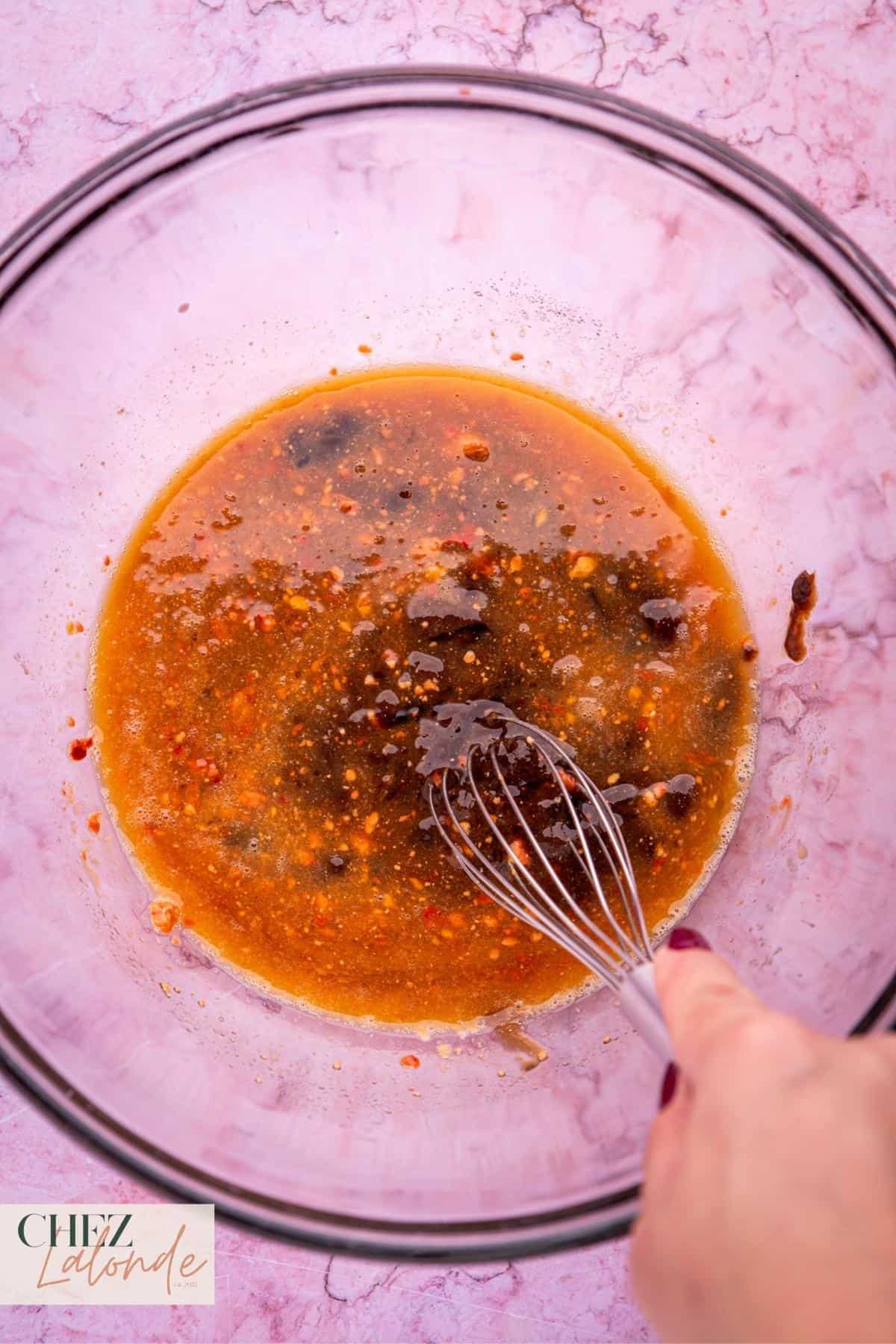
Step 4: Add in coloring and reserve some marinade.
Once the marinade is thoroughly mixed, add 5 to 6 drops of red food coloring to intensify the pork’s vibrant red hue. It’s important to note that adding food coloring is optional; you can omit it if desired. As a next step, set aside approximately ¼ cup of the marinade for later use.
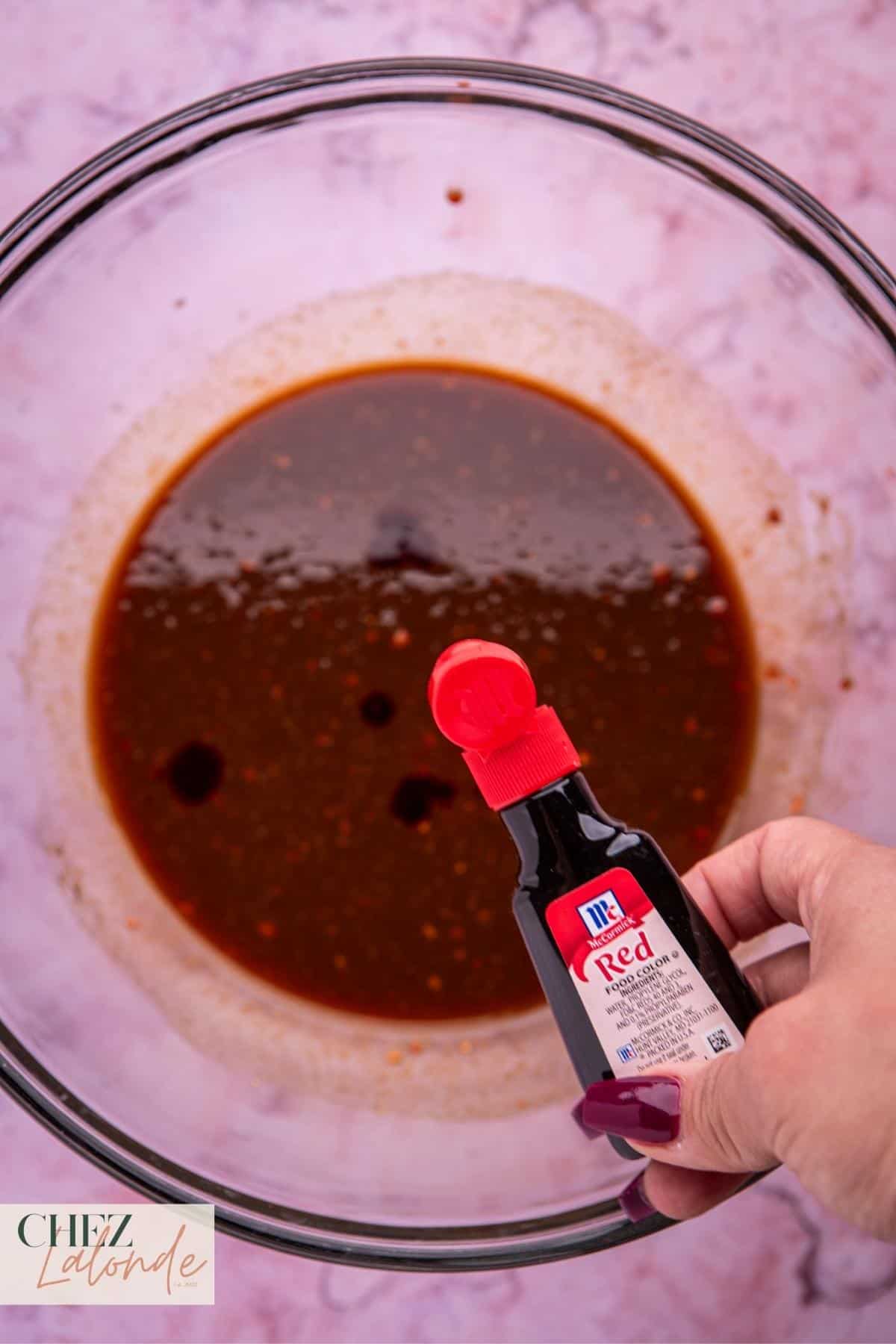
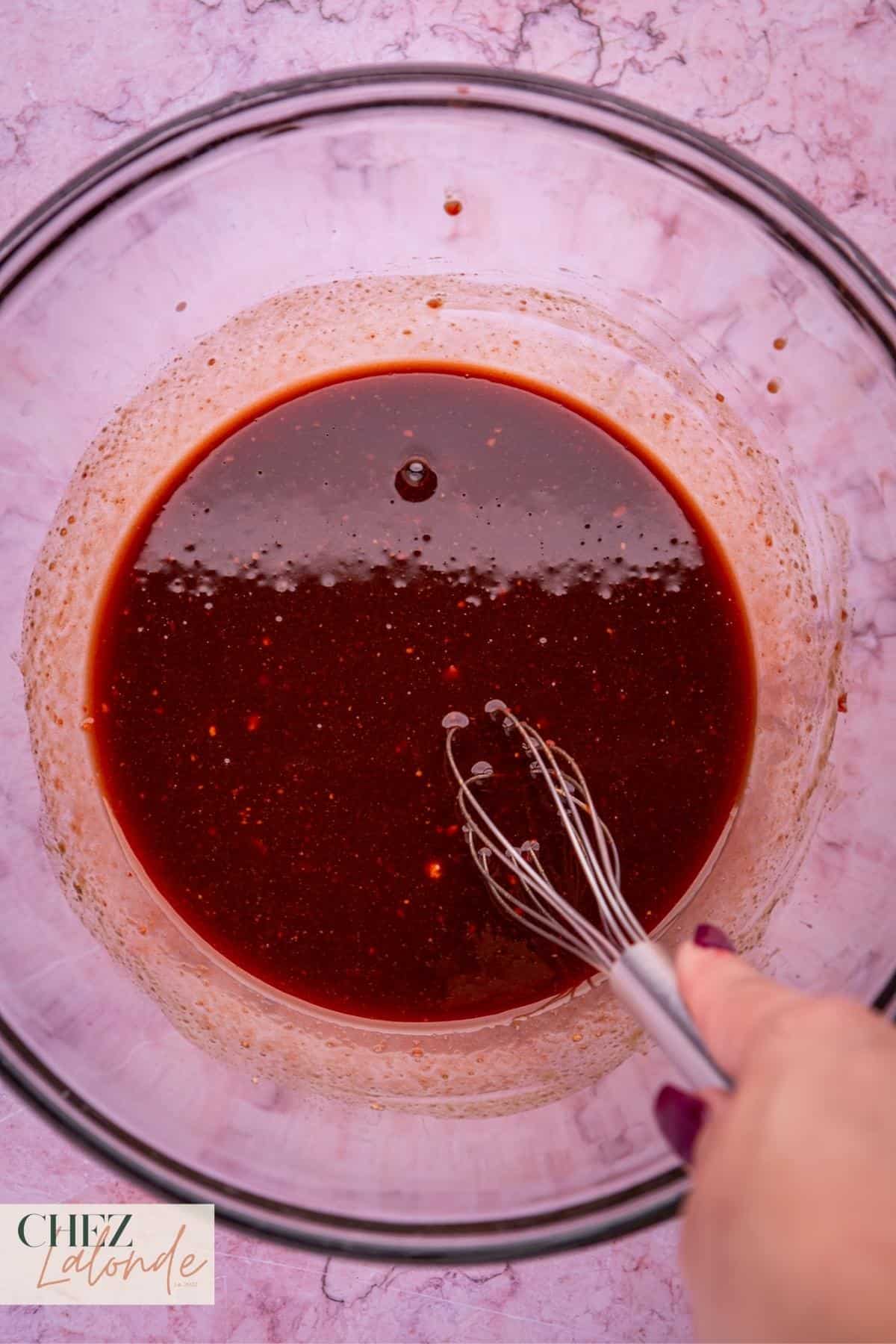
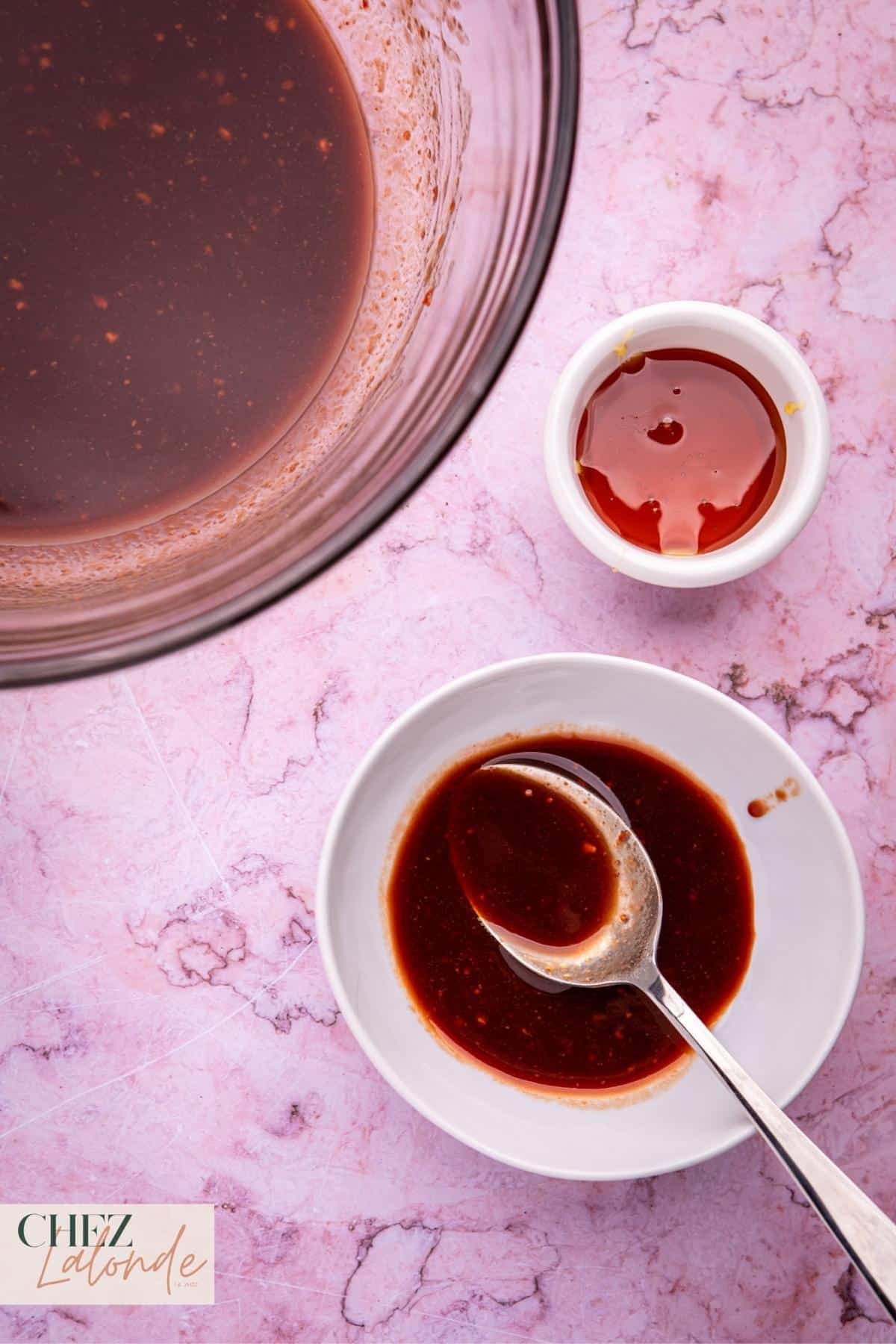
Step 5: Prepare a Ziploc bag and marinate the pork
Position a freezer-grade Ziploc bag atop a slender bowl, carefully nestling the pork within the bag’s confines. Proceed to pour the prepared Char Siu marinade into the bag. Lift the Ziploc bag from the bowl, seal it securely, and tenderly massage the pork to ensure the marinade envelops it completely. With the marinating process underway, transfer the bag to the refrigerator, allowing the pork to soak in the flavors for at least one hour. For intensified taste, feel free to let it marinate overnight.
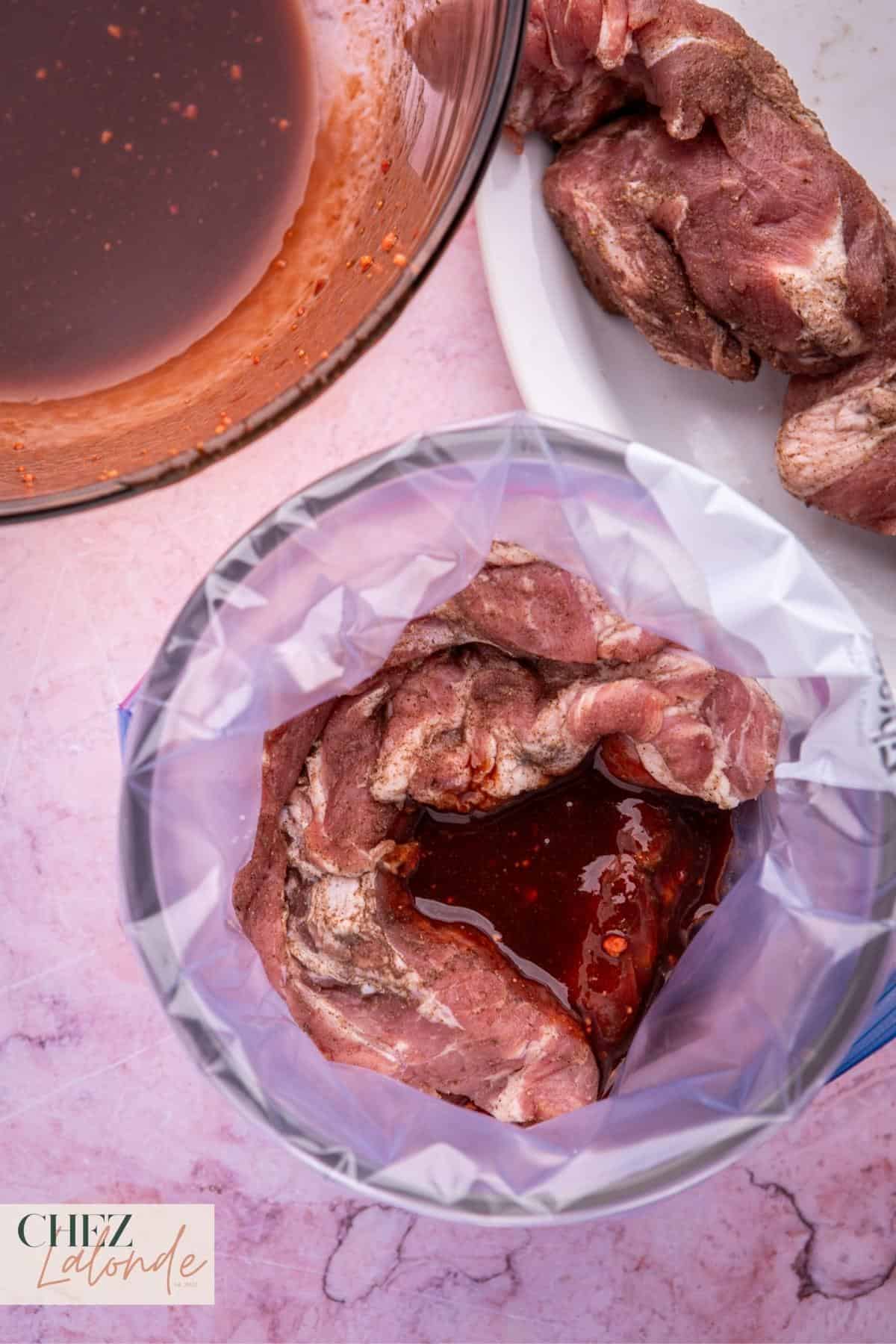
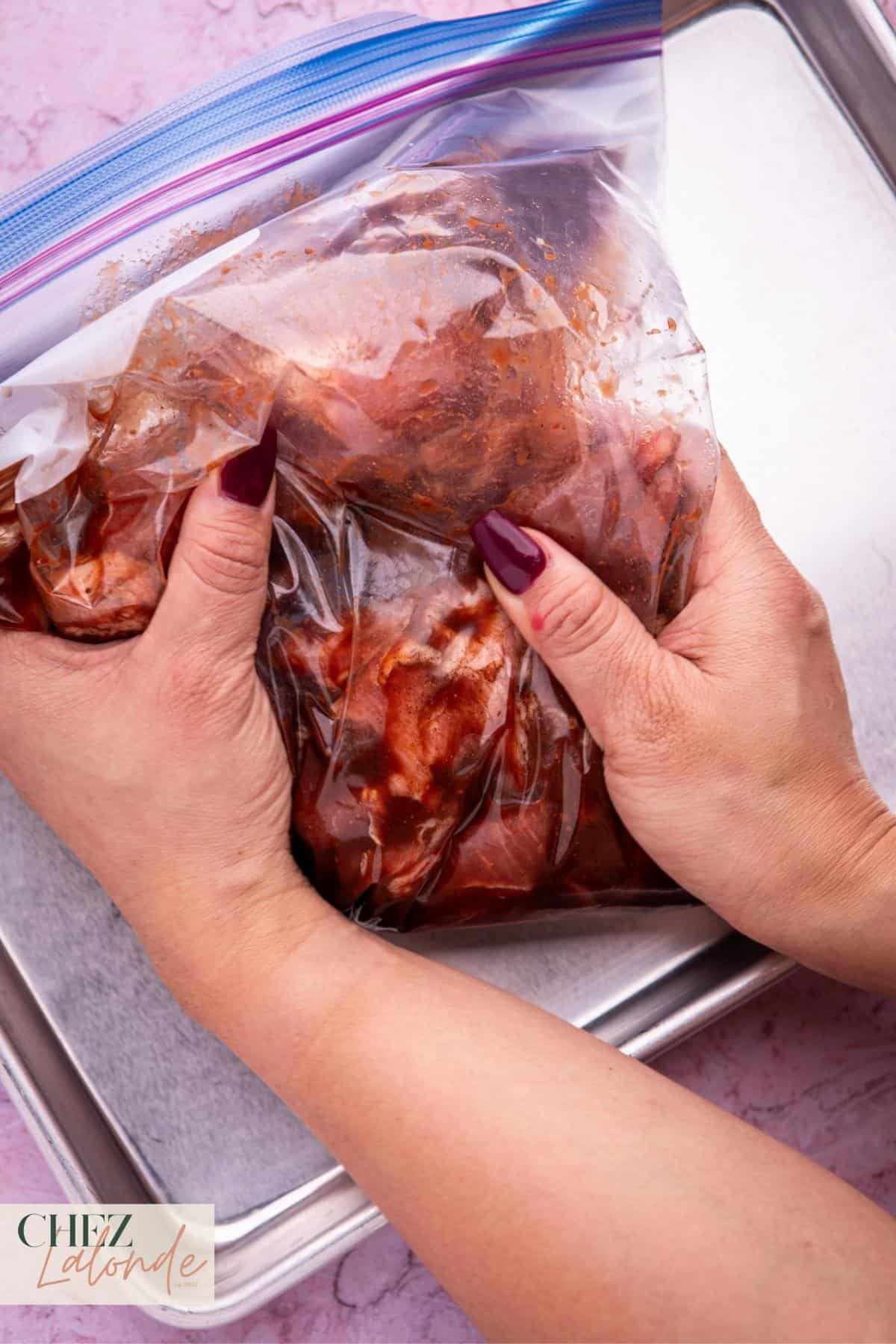
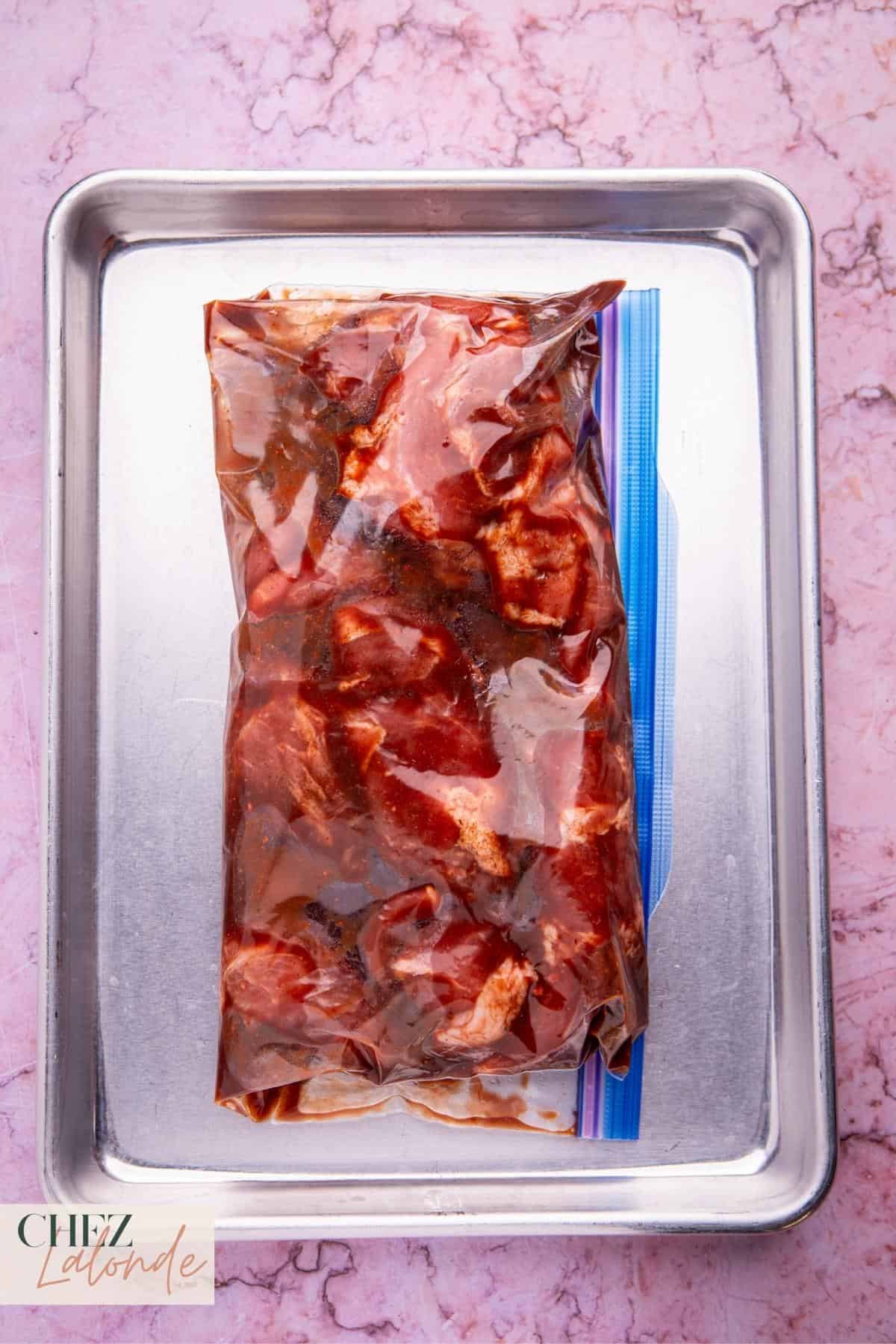
Step 6: Prepare the basting sauce
Combine the marinade that was set aside earlier with 2 tablespoons of maltose syrup in a smaller bowl. Note that maltose syrup tends to be thick and challenging to blend with the marinade. To ease this process, consider placing the mixing bowl in a warm water bath to help the syrup dissolve more swiftly. Whisk the mixture until a cohesive blend is achieved, then set it aside for future use.

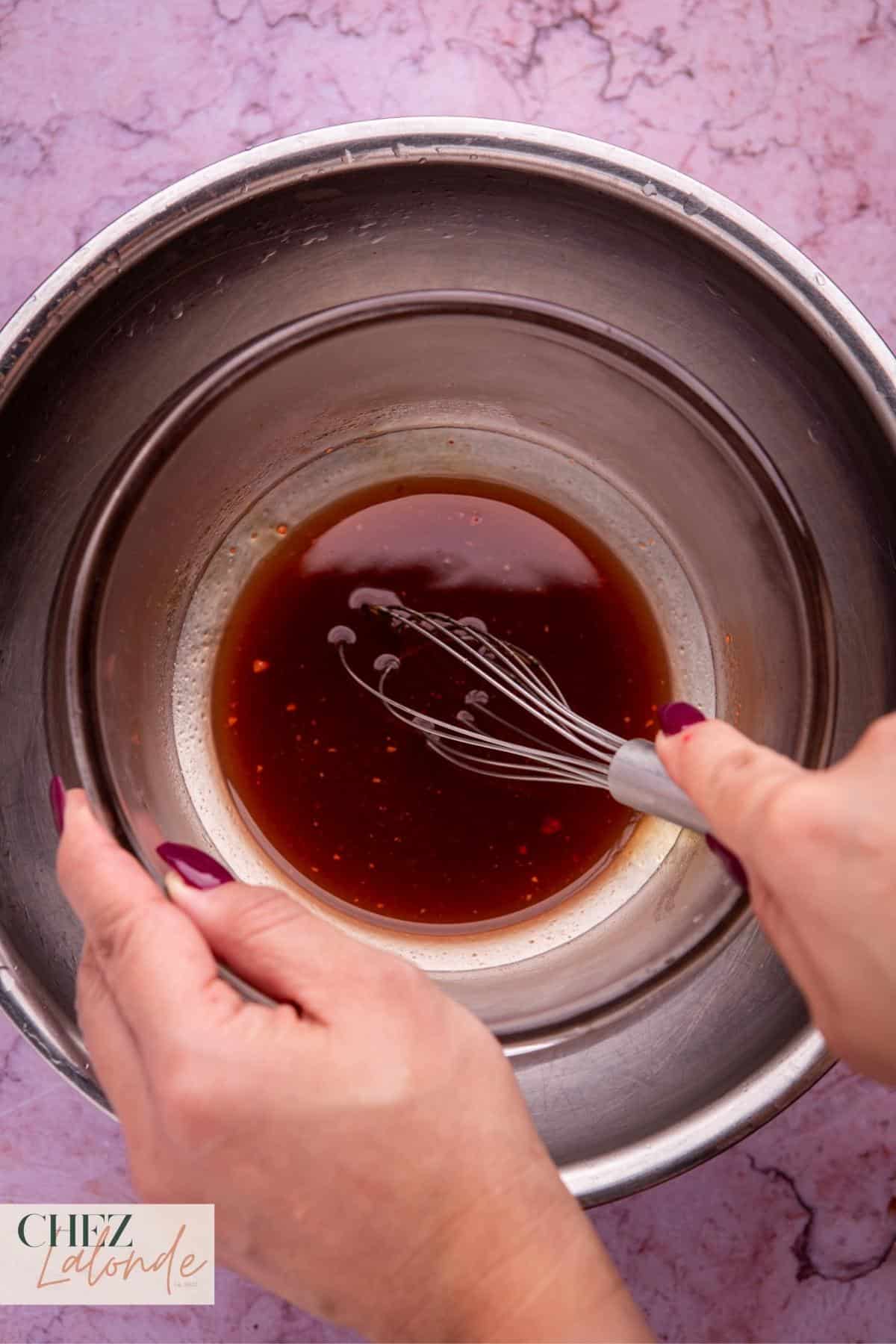
Step 7: Prepare Sous Vide
Pour water into a Sous Vide container or a deep 16-quart stainless steel stockpot. Gently insert your Sous Vide immersion circulator, ensuring it’s securely in place, and set the cooking temperature to 150°F/66°C.


Step 8: Start the Sous Vide cooking process
Once the Sous Vide water reaches the desired temperature, use the water displacement method to gently submerge the marinaded pork in a Ziploc bag into the water bath. Ensure no water enters the bag. As the bag is partially immersed, it will expel air, preventing it from floating. Seal the Ziploc bag securely. For consistent heat, if you have a similar Sous Vide container, cover it at the top to retain warmth. Clip the bag to the container’s side, and Sous Vide cooking for at least 4 but no longer than 6 hours.
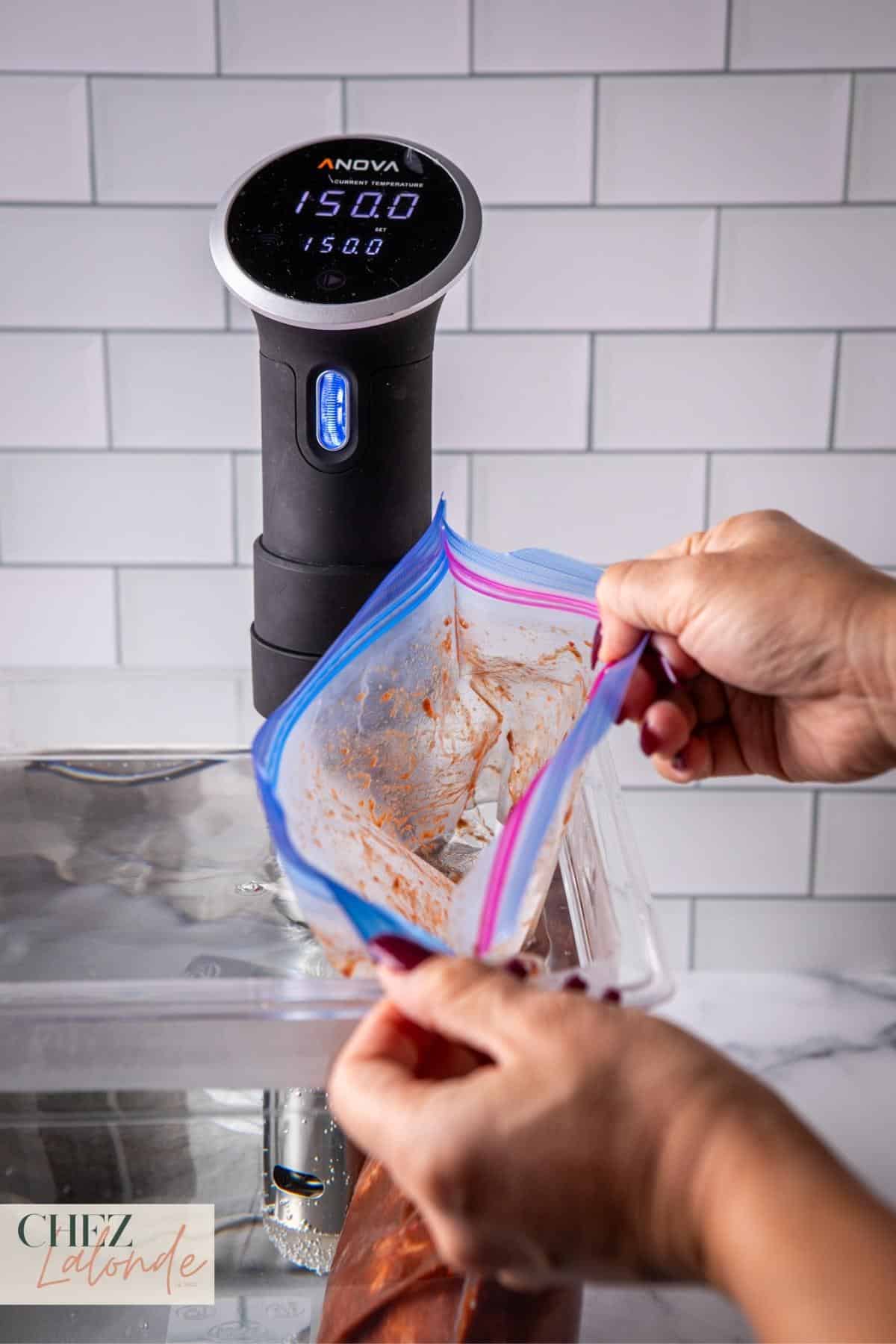
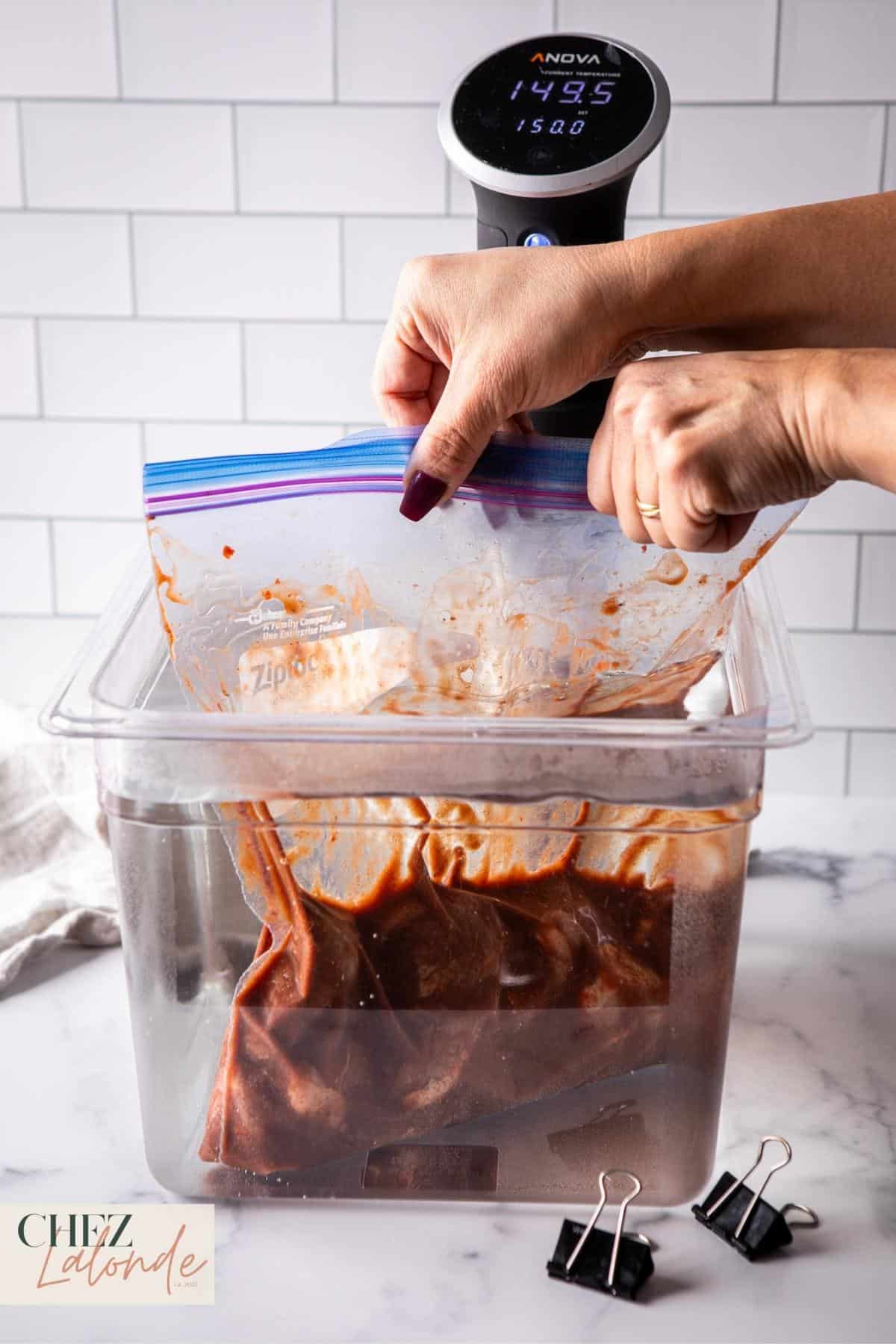
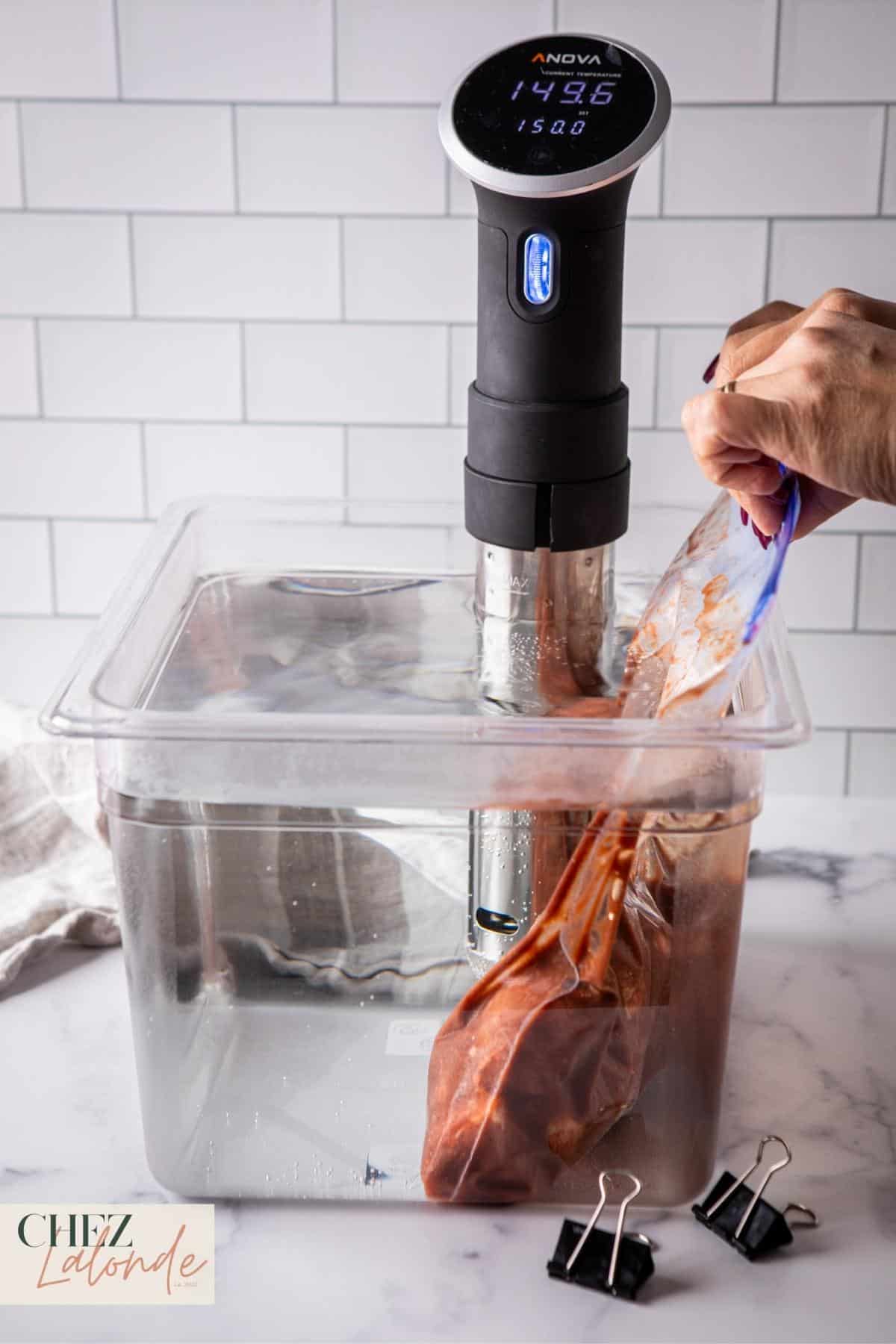
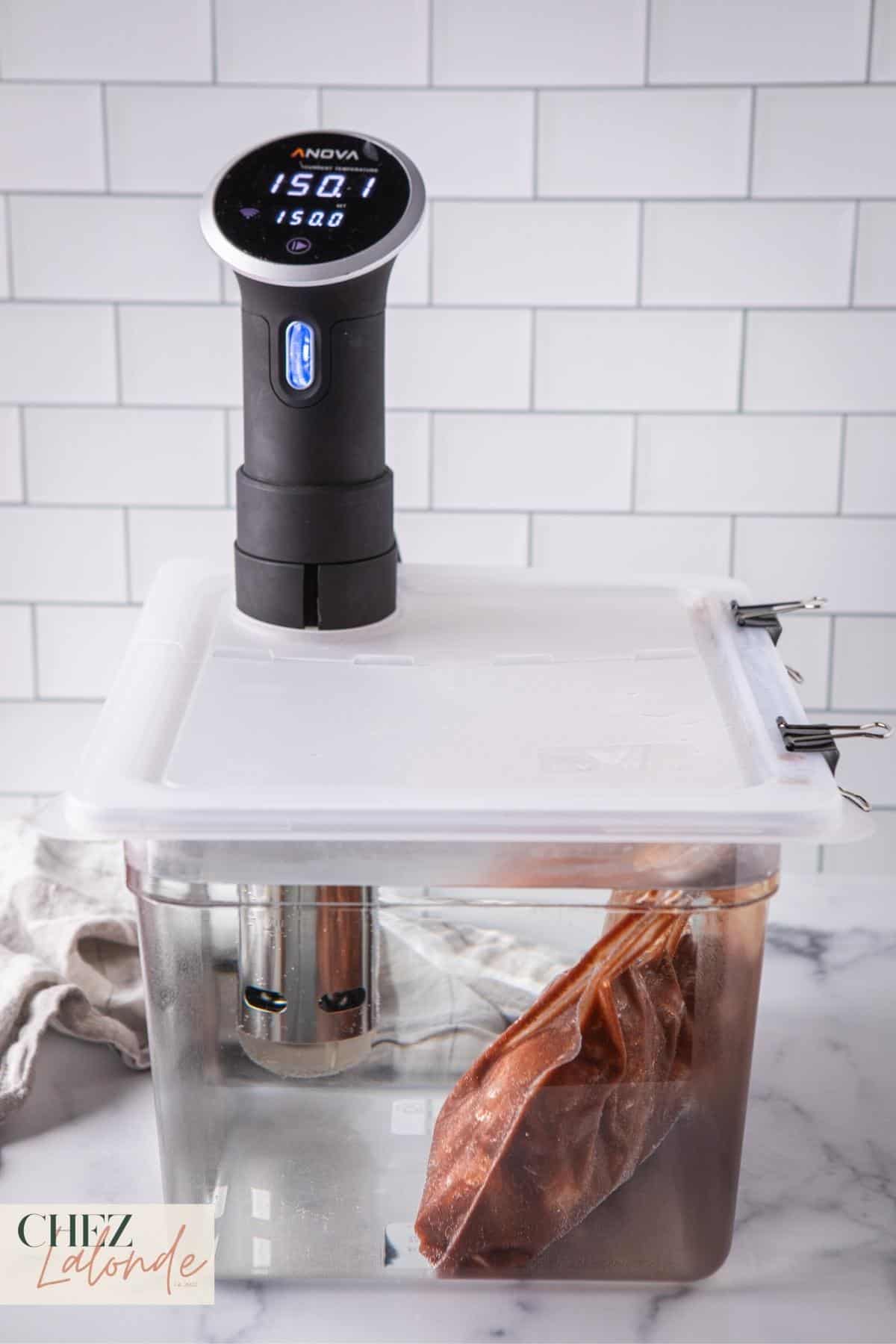
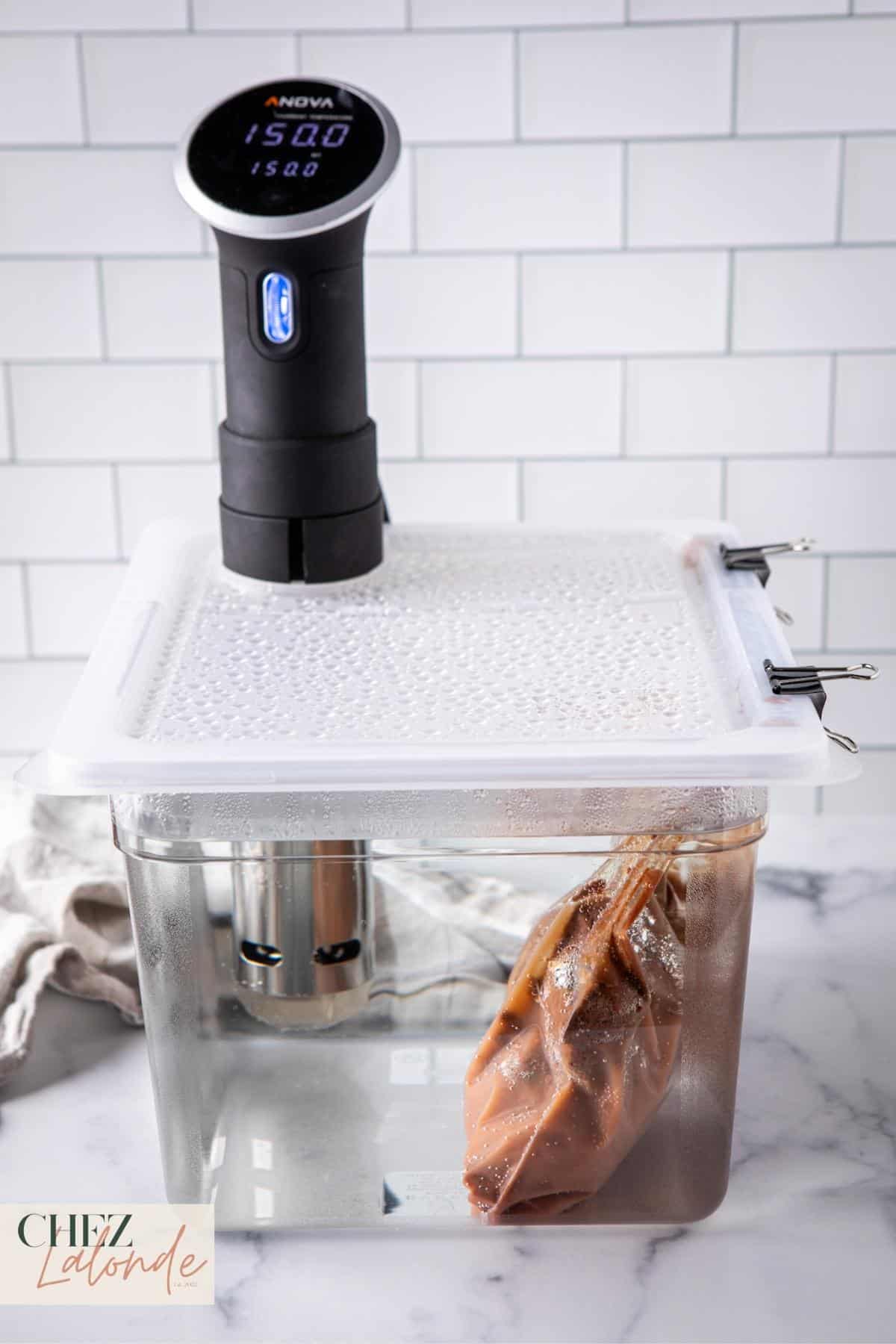

Step 9: Final Step – Broil the pork
Once the Sous Vide cooking is complete, take the pork out of the Ziploc bag, disposing of both the bag and its contents. Arrange the Char Siu pork on a roasting pan. Apply the basting of the reserved marinade and syrup mixture. Set the pork beneath a high broiler setting and broil for 16 minutes (8 minutes on each side). Remember to baste the pork every 4 minutes to retain its moisture. Once a charred surface forms, remove the pork and allow it to rest for 5 to 10 minutes before slicing.
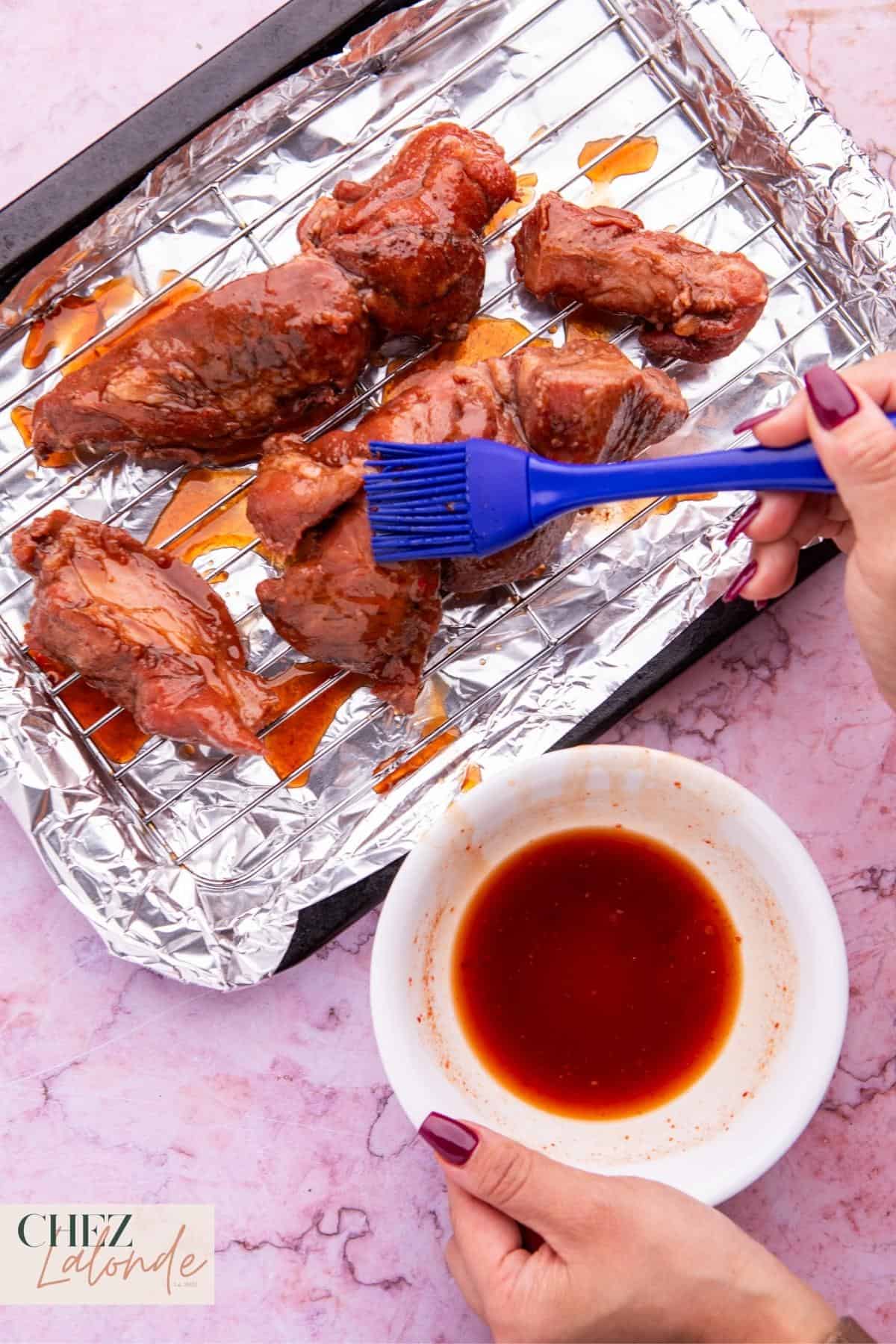

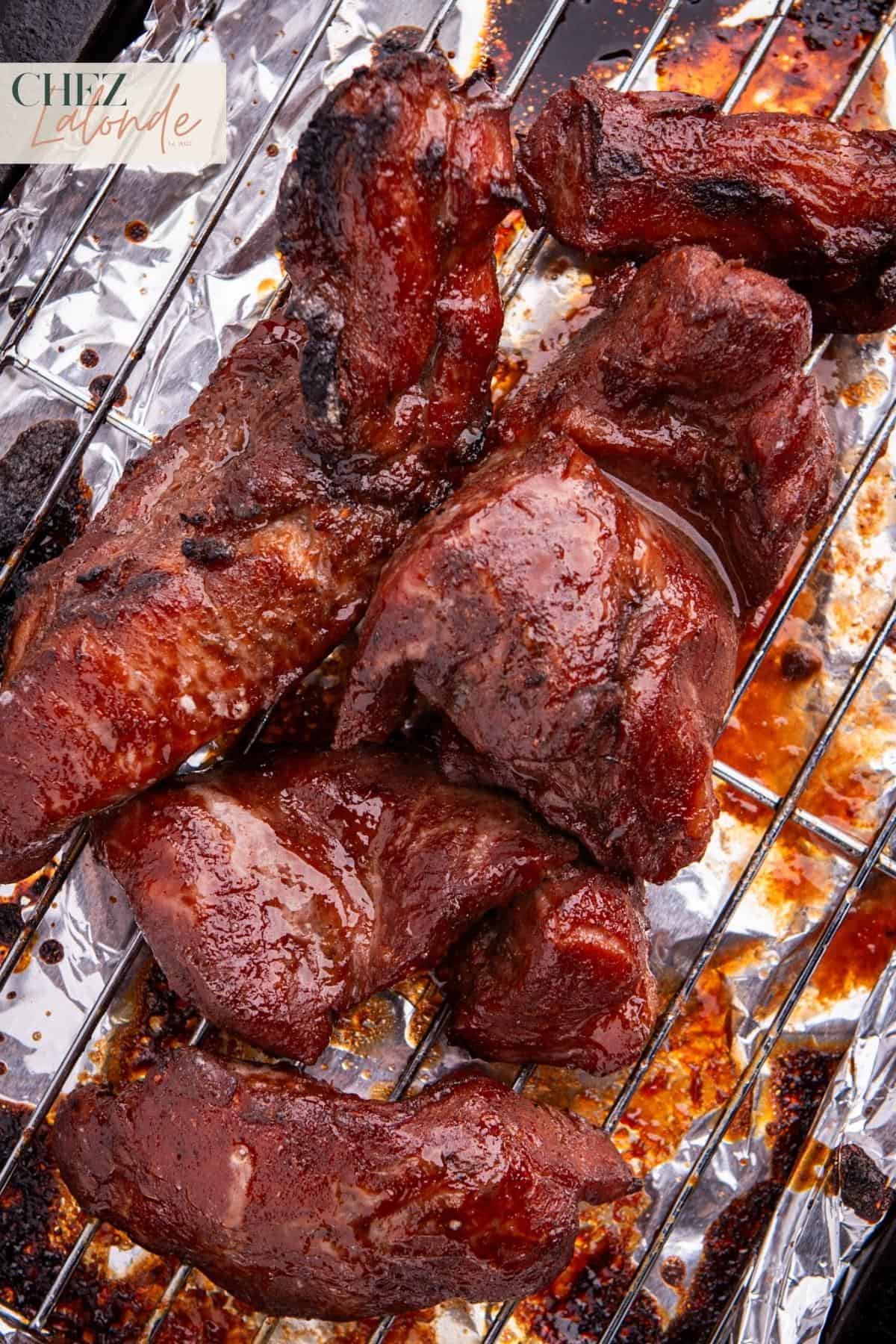
Step 10: Slice, serve, and enjoy
After the pork has rested, slice pork into approximately quarter-inch thick pieces. For the ultimate indulgence, serve it over rice or on a rice platter alongside steamed veggies. Top the experience with a perfectly cooked sunny-side-up egg and drizzle with soy sauce for additional flavor.
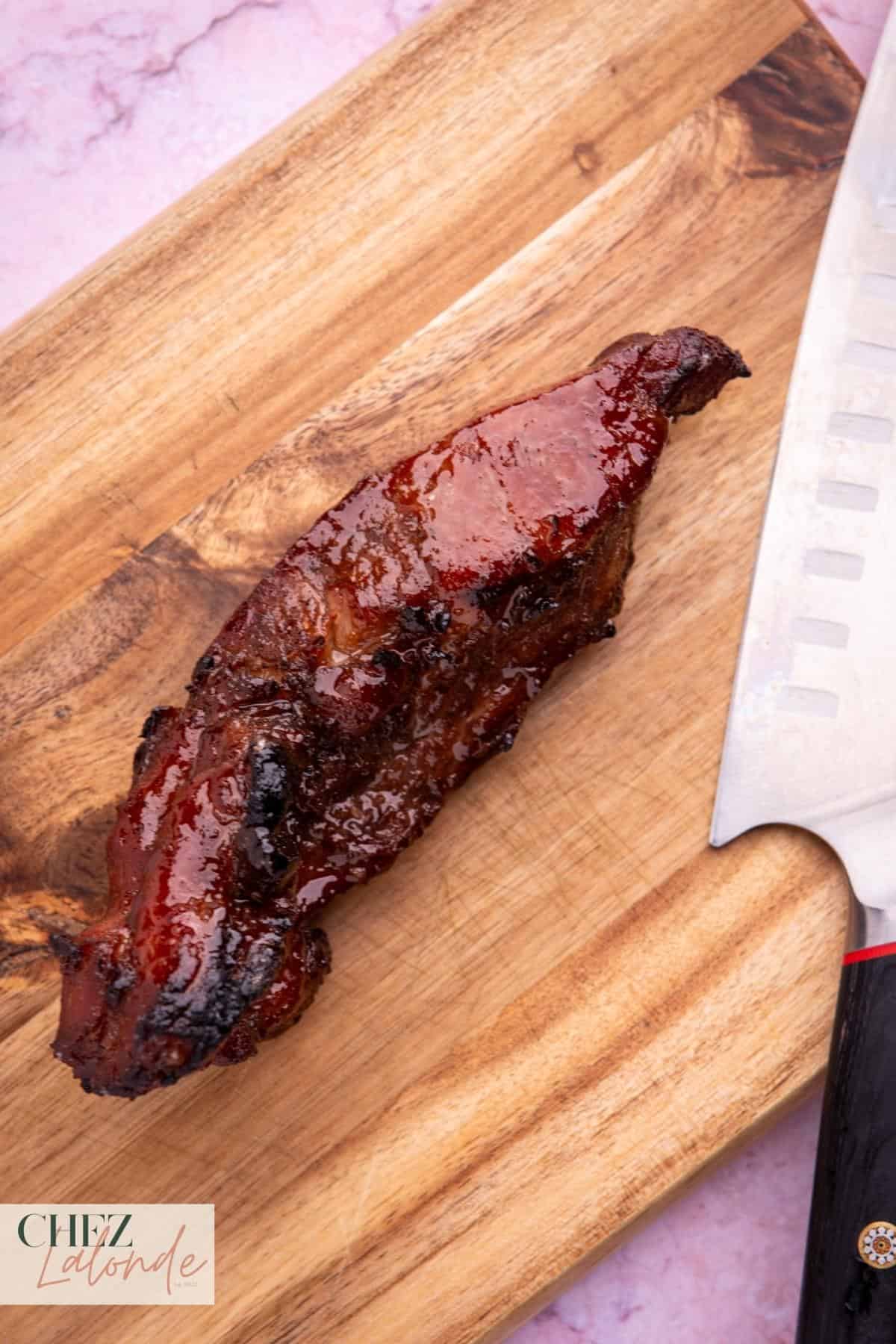
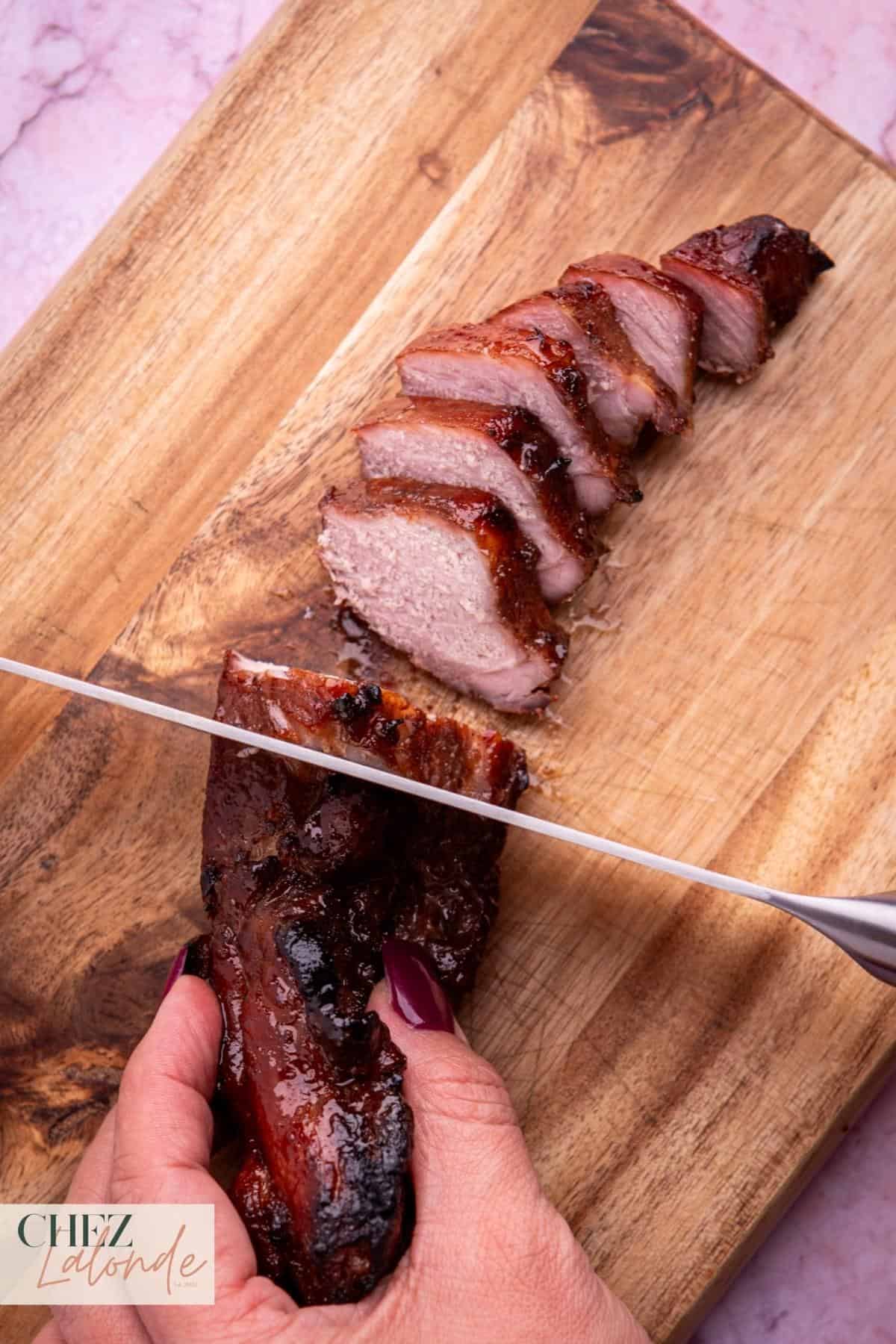
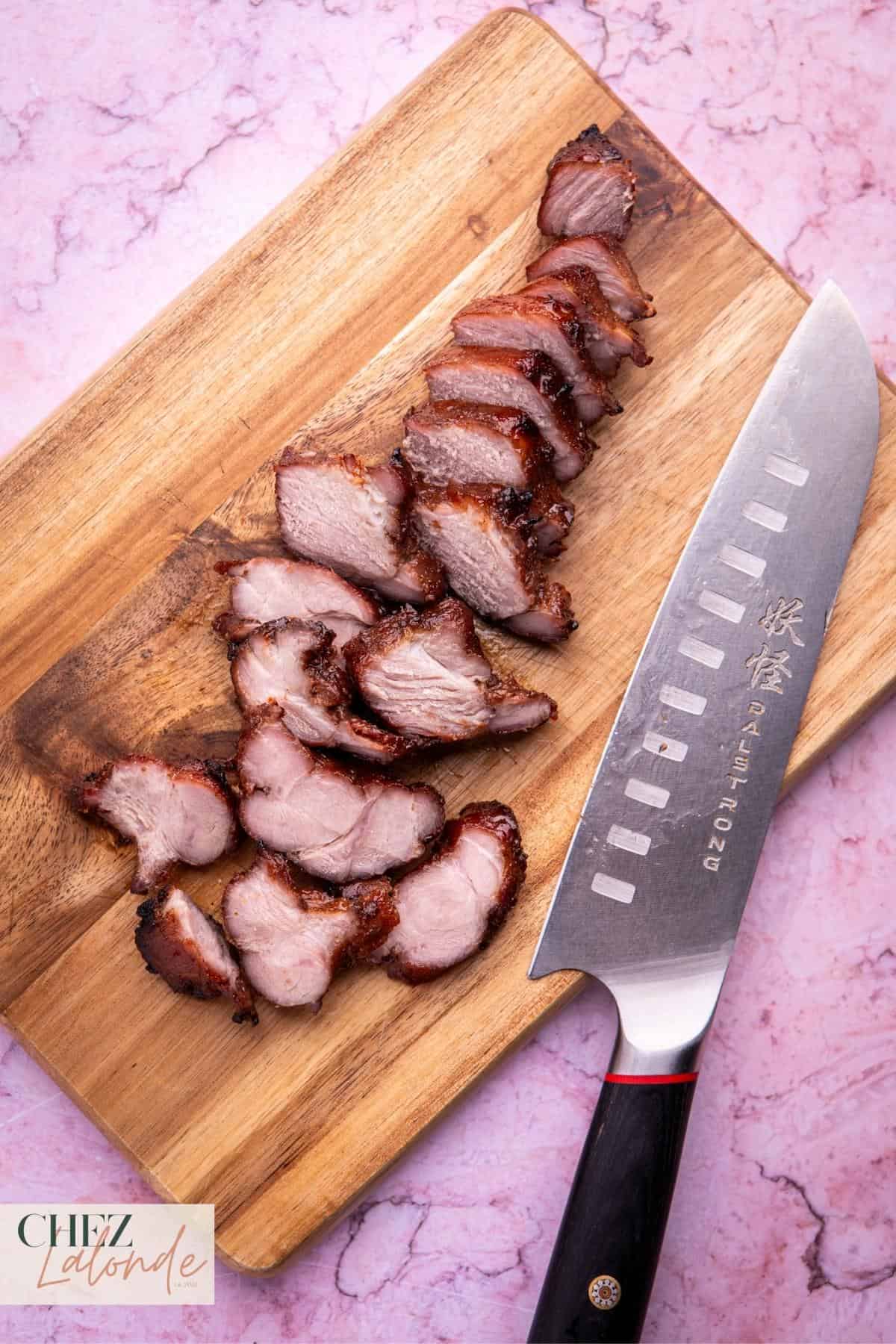
What to serve with this Sous Vide dish?
The versatility of this Chinese BBQ pork knows no bounds. It effortlessly complements an array of authentic Chinese dishes. Here’s a glimpse into how I adore pairing this delectable pork:
- Char Siu Fried Rice – My trusty go-to dinner idea when I have no time to prep my meal and the fridge is full of mismatched leftover ingredients. (as showcased below)
- Char Siu Scrambled Eggs (a cherished childhood comfort)
- Char Siu Rice Platter crowned with sunny-side-up eggs and steamed veggies (as showcased below)
- Served with steamed white rice (as showcased below)
- Char Siu Bao – Steamed BBQ pork buns (From Rasa Malaysia)
- Char Siu-steamed Rice Noodle Rolls (From Hungry Huy)
- Char Siu Chow Mein (From Omnivore’s Cookbook)
- Char Siu Lo Mein – (From The Woks Of Life)
And that’s merely the tip of the iceberg – your creativity is the limit!


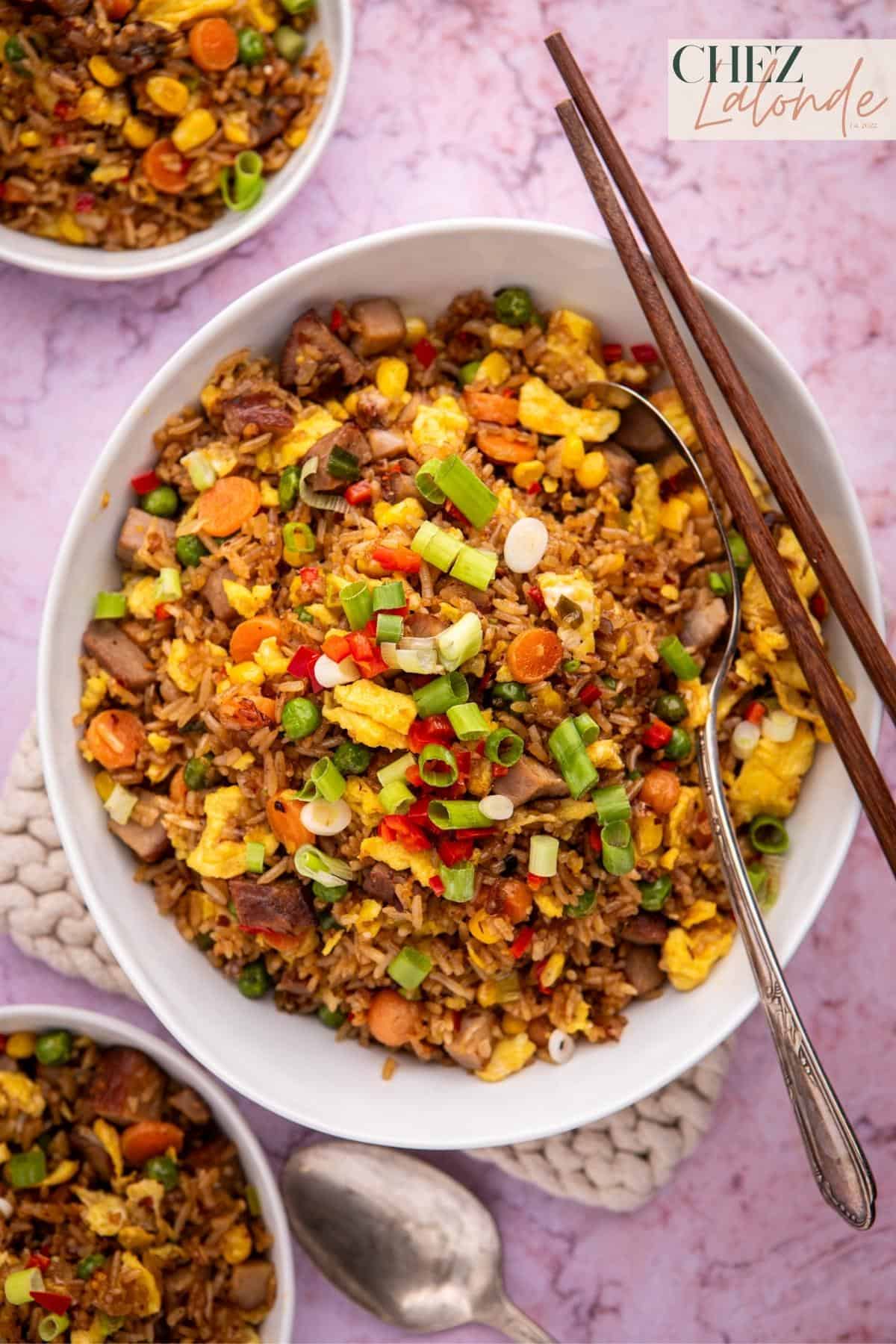
For even more delicious Asian recipes, you may like these:
Tips and tricks for this recipe:
Precise Pork Cutting:
When working with pork, ensure you cut along the grain in long strips, avoiding any cuts across it. This preserves the pork’s texture and guarantees tenderness.
Amplifying the Red Hue:
While red food coloring isn’t necessary for homemade Char Siu, a few drops can be your ticket to achieving that vibrant restaurant-like appearance.
Glossy Perfection:
Want that glossy, irresistible allure? Incorporate Meltosy syrup honey – the secret to creating a restaurant-worthy finish.
Lock in Moisture:
Post-Sous Vide, a flavorful char is the goal. Keep the meat moist by reserving some marinade for basting during broiling – a simple trick for juicy, succulent results.
Rest for Flawlessness:
Allow your masterpiece to rest 5 to 10 minutes after the oven to ensure the meat locks in all its juicy goodness, delivering a flawless, flavorful experience.

Reheating and leftover storage tips:
Refrigeration:
Store leftover Sous Vide Char Siu in an airtight container once it has cooled down to room temperature. You should store within 2 hours of cooking to maintain freshness. You can refrigerate leftover BBQ pork for 3 to 4 days for optimal taste.
Reheating:
Reheating your Char Siu is a breeze! Warm it up in the microwave for 1 to 2 minutes, or use a toaster oven at 325F/163C for 5 to 8 minutes. And if you’re feeling laid-back, enjoy it at room temperature – just like how restaurants often serve it.
Freezing:
Freezing cooked BBQ pork is an option, though it’s not something I typically do since I prefer freshly prepared meals. This recipe yields ideal portions for two with leftovers or a small family of 4 to 5. If you plan ahead, consider freezing the marinated BBQ pork for convenient Sous Vide cooking later. However, I recommend refrigerating cooked Char Siu and enjoying it within a few days for the best taste and quality if it’s already cooked.

FAQs about Sous Vide Char Siu:
Find out more delicious Sous Vide recipes here:
In Conclusion
And just like that, we’ve ended our Sous Vide Char Siu adventure! Armed with the perfect fusion of timeless flavors and contemporary Sous Vide cooking methods, you can whip up a restaurant-worthy masterpiece in your kitchen. So, dive in, let your culinary creativity run wild, and turn this recipe into a cherished family dinner staple – just as I have. Happy cooking, and here’s to countless delectable moments at your table!
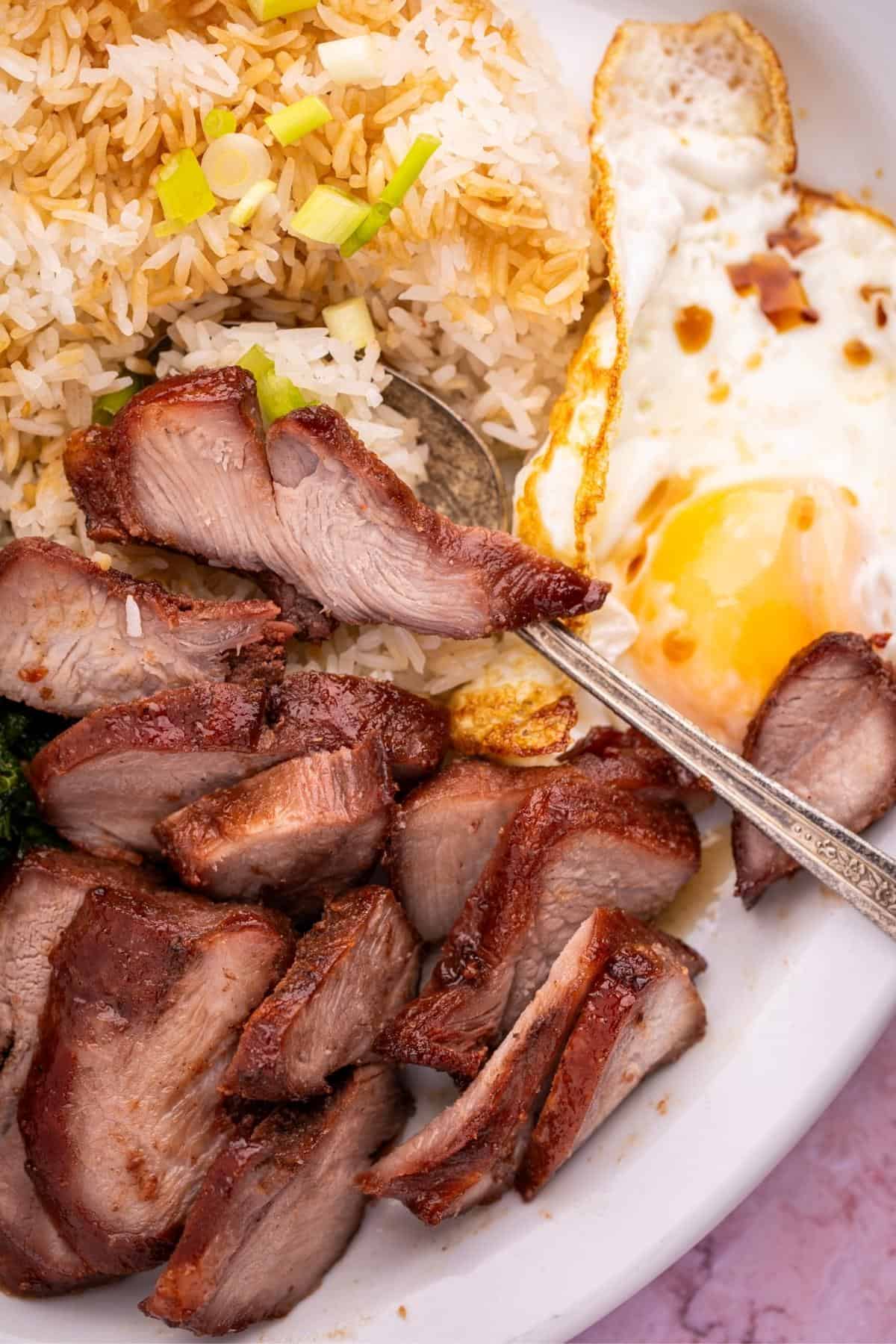
Did you make this recipe?
Don’t miss out on the flavorful adventure – join me in the kitchen, and let’s create something amazing together! Follow my blog for culinary inspiration, tips, and recipes to elevate your cooking game. Let’s connect, share, and savor every moment!

Sous Vide Char Siu 叉燒 (Chinese-Style BBQ Pork)
- Total Time: 28 hours 20 minutes
- Yield: 4 servings 1x
Description
Master the art of Sous Vide Char Siu (Chinese BBQ Pork) with our foolproof recipe. Achieve tender, succulent pork infused with traditional flavors. Elevate your culinary skills and explore the world of Sous Vide cooking. Follow for more delectable recipes and cooking tips!
Ingredients
2 Lbs of Pork Butt or Shoulder
1/4 Teaspoon of White pepper
1/2 Teaspoon of Five Spice powder
1/2 Teaspoon of Garlic Powder
1/2 Teaspoon of Sea Salt
1 piece of Fermented red bean curd
1 Tablespoon of Juice from fermented Bean Curd
1 Large size Egg
2 Tablespoons of Chinese Rose Wine
2 Tablespoons of Soy sauce
2 Tablespoons of Ground bean sauce
2 Tablespoons of Hoisin sauce
1 Tablespoon of Char Siu sauce
5 to 6 drops of Red food coloring (Optional)
2 Tablespoons of Maltose Syrup
Instructions
Begin by carefully removing any silver lining, impurities, or excess fat from the pork. Rinse it under running water thoroughly and gently pat it dry using fresh paper towels.
Step 2: Apply dry rub on the pork
In a small dish or bowl, combine ¼ teaspoon of white pepper and ½ teaspoon each of sea salt, five spice powder, and garlic powder. Sprinkle the dry rub mixture evenly over the pork and gently massage the flavors into the meat. Set aside and allow the seasoned pork to rest for 15 to 20 minutes, giving the flavors time to meld and enhance.
Step 3: Prepare Char Siu Marinade
While the pork is resting, start to prepare the Char Siu marinade. In a large bowl, whisk a large egg, combining it with a piece of fermented red bean curd and a tablespoon of red bean curd juice. Break down the bean curd into finer pieces using your whisk. Once integrated, add the remaining marinade ingredients, including soy sauce, Chinese rose wine, sugar, salt, ground bean sauce, Hoisin sauce, and Char Siu sauce. Whisk and make sure all are well combined.
Step 4: Add in coloring and reserve some marinade.
Once the marinade is thoroughly mixed, add 5 to 6 drops of red food coloring to intensify the pork’s vibrant red hue. It’s important to note that adding food coloring is optional; you can omit it if desired. As a next step, set aside approximately ¼ cup of the marinade for later use.
Step 5: Prepare a Ziploc bag and marinate the pork
Position a freezer-grade Ziploc bag atop a slender bowl, carefully nestling the pork within the bag’s confines. Proceed to pour the prepared Char Siu marinade into the bag. Lift the Ziploc bag from the bowl, seal it securely, and tenderly massage the pork to ensure the marinade envelops it completely. With the marinating process underway, transfer the bag to the refrigerator, allowing the pork to soak in the flavors for at least one hour. For intensified taste, feel free to let it marinate overnight.
Step 6: Prepare the basting sauce
Combine the marinade that was set aside earlier with 2 tablespoons of maltose syrup in a smaller bowl. Note that maltose syrup tends to be thick and challenging to blend with the marinade. To ease this process, consider placing the mixing bowl in a warm water bath to help the syrup dissolve more swiftly. Whisk the mixture until a cohesive blend is achieved, then set it aside for future use.
Step 7: Prepare Sous Vide
Pour water into a Sous Vide container or a spacious and deep soup pot. Gently insert your immersion circulator, ensuring it’s securely in place, and set the cooking temperature to 150°F/66°C.
Step 8: Start the Sous Vide cooking process
Once the Sous Vide water reaches the desired temperature, use the water displacement method to gently submerge the marinaded pork in a Ziploc bag into the water bath. Ensure no water enters the bag. As the bag is partially immersed, it will expel air, preventing it from floating. Seal the Ziploc bag securely. For consistent heat, if you have a similar Sous Vide container, cover it at the top to retain warmth. Clip the bag to the container’s side, and Sous Vide cooking for at least 4 but no longer than 6 hours.
Step 9: Final Step – Broil the pork
Once the Sous Vide cooking is complete, take the pork out of the Ziploc bag, disposing of both the bag and its contents. Arrange the pork on a baking sheet. Apply the basting of the reserved marinade and syrup mixture. Set the pork beneath a high broiler setting and broil for 16 minutes (8 minutes on each side). Remember to baste the pork every 4 minutes to retain its moisture. Once a charred surface forms, remove the pork and allow it to rest for 5 to 10 minutes before slicing.
Step 10: Slice, serve, and enjoy
After the pork has rested, slice it into approximately quarter-inch thick pieces. For the ultimate indulgence, serve it over rice or on a rice platter alongside steamed veggies. Top the experience with a perfectly cooked sunny-side-up egg and drizzle with soy sauce for additional flavor.
Notes
Precise Pork Cutting: When working with pork, ensure you cut along the grain in long strips, avoiding any cuts across it. This preserves the pork’s texture and guarantees tenderness.
Amplifying the Red Hue: While red food coloring isn’t necessary for homemade Char Siu, a few drops can be your ticket to achieving that vibrant restaurant-like appearance.
Glossy Perfection: Want that glossy, irresistible allure? Incorporate Meltosy syrup honey – the secret to creating a restaurant-worthy finish.
Lock in Moisture: Post-Sous Vide, a flavorful char is the goal. Keep the meat moist by reserving some marinade for basting during broiling – a simple trick for juicy, succulent results.
Rest for Flawlessness: Allow your masterpiece to rest for 5 to 10 minutes after the oven to ensure the meat locks in all its juicy goodness, delivering a flawless, flavorful experience.
- Prep Time: 24 hours
- Cook Time: 260 minutes
- Category: Asian Cuisine
- Method: Sous Vide
- Cuisine: Chinese
Keywords: Chinese BBQ Pork, Sous Vide, Char Siu, Cantonese cuisine, Broiler


